Hotpoint-Ariston KIC 641 X: instruction
Class: Built-in hobs
Type:
Manual for Hotpoint-Ariston KIC 641 X

English
GB
Operating Instructions
HOB
Contents
Operating Instructions,1
Description of the appliance-Control Panel,2
Installation,7
Start-up and use,9
Precautions and tips,14
Care and maintenance,15
Technical description of the models,15
FR
Français
Mode d’emploi Manutenção e cuidados
TABLE DE CUISSON
Sommaire
Mode d’emploi,1
Description de l’appareil-Tableau de bord, 2
Installation,16
Mise en marche et utilisation,18
Précautions et conseils, 23
Nettoyage et entretien,24
Description technique des modèles,24
Español
ES
Manual de instrucciones
ENCIMERA
Sumario
Manual de instrucciones,1
Descripción del aparato-Panel de control,2
Instalación,25
Puesta en funcionamiento y uso,27
Precauciones y consejos,32
Mantenimiento y cuidados,33
Descripción técnica de los modelos,33
Instruções para a utilização
PLANO
Índice
Instruções para a utilização,1
Descrição do aparelho-Painel de comandos,2
Instalação, 34
Início e utilização, 36
Precauções e conselhos,41
Manutenção e cuidados,42
Descrição técnica dos modelos,42
PT
Português
DE
Bedienungsanleitung
KOCHFELD
Inhaltsverzeichnis
Bedienungsanleitung,1
Beschreibung des Gerätes- Bedienfeld,2
Installation, 43
Inbetriebsetzung und Gebrauch,45
Vorsichtsmaßregeln und Hinweise, 50
Reinigung und Pflege, 51
Technische Beschreibung der Modelle, 51
NL
PL
RS
Italiano
IT
Istruzioni per l’uso
PIANO COTTURA
Sommario
Istruzioni per l’uso,1
Descrizione dell’apparecchio- Pannello di controllo,2
Installazione, 52
Avvio e utilizzo,54
Precauzioni e consigli,58
Manutenzione e cura,59
Descrizione tecnica dei modelli,59
Deutsch
Nederland
Gebruiksaanwijzing
KOOKPLAAT
Inhoud
Gebruiksaanwijzing,1
Beschrijving van het apparaat-Bedieningspaneel,2
Installatie, 60
Starten en gebruik, 62
Voorzorgsmaatregelen en advies,66
Onderhoud en verzorging,67
Technische beschrijving van de modellen,67
Polski
Instrukcja obs
ł
ugi
P
Ł
YTA GRZEJNA
Spis tre
ś
ci
Instrukcja obs
ł
ugi,1
Opis urz
ą
dzenia-Panel sterowania,2
Instalacja,68
Uruchomienie i u
ż
ytkowanie,70
Zalecenia i
ś
rodki ostro
ż
no
ś
ci,74
Konserwacja i utrzymanie,75
Opis Techniczny,75
P
усский
инструкция
по
эксплуатации
плита
C
одержание
Инструкция
по
эксплуатации
, 1
Описание
прибора
-
Панель
управления
,2
Монтаж
,76
B
арочная
панель
,78
Предосторожности
и
рекомендации
,82
Техническое
обслуживание
и
уход
,83
Техническое
обслуживание
,84
KIA 641 C
KIA 641 B
KIC 641 X
KIC 642 C
KIC 644 X
KIC 644 C
KIC 644 DD Z
KIC 744 C
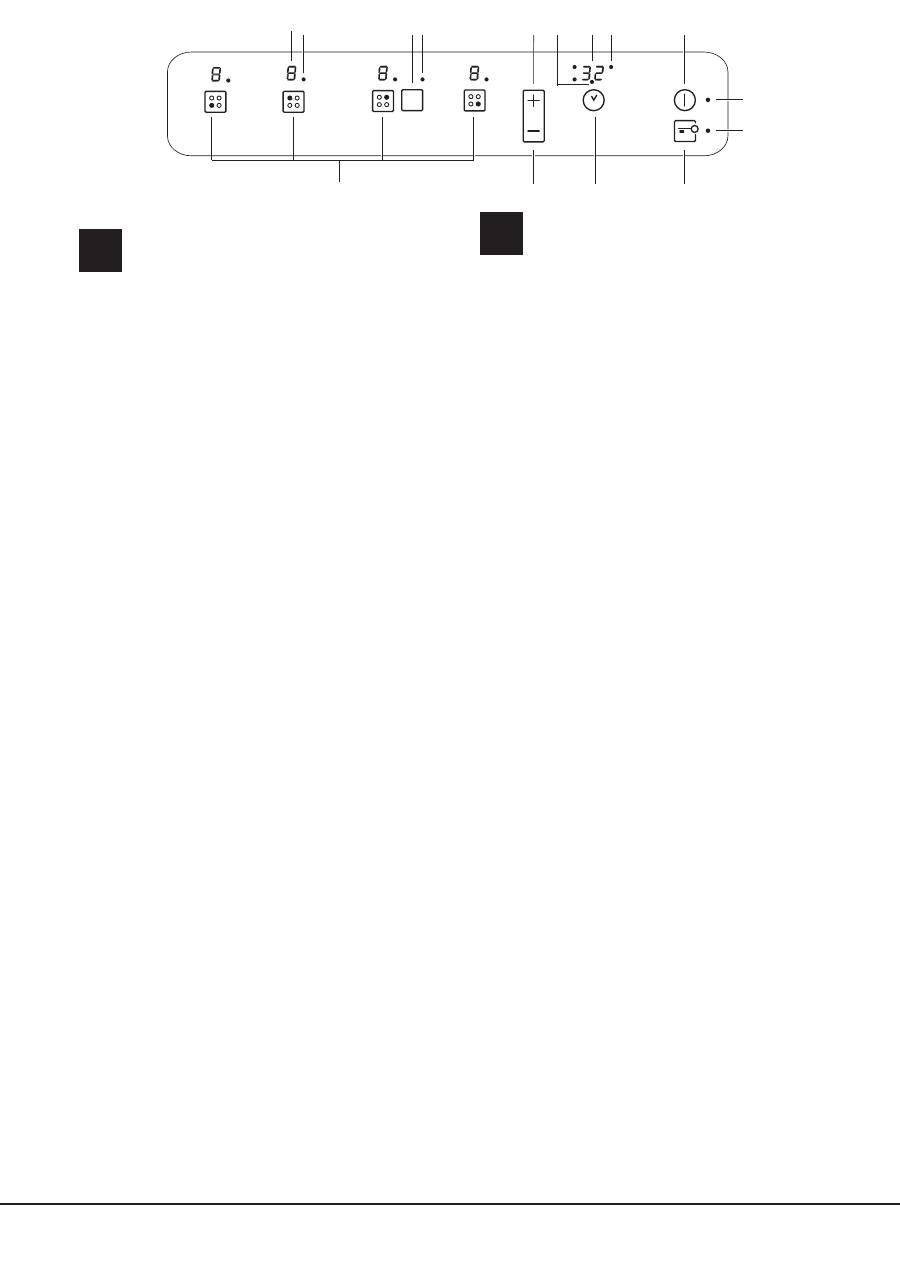
2
Description of the appliance
Control panel
GB
Description de l’appareil
Tableau de bord
FR
The control panel described in this manual is only a
representative example: it may not exactly match the panelon
your appliance.
1
INCREASE POWER
button switches on the hotplate
and controls the power (
see Start-up and use
).
2
REDUCE POWER
button controls the power and
switches off the hotplate (
see Start-up and use
).
3
COOKING ZONE SELECTOR
indicator shows a
particular cooking zone has been selected and
therefore various adjustments are possible.
4
COOKING ZONE SELECTOR
button is used to
select the desired cooking zone.
5
POWER
indicator provides a visual display for the
current heat level.
6
ON/OFF
button switches the appliance on and off.
7
ON/OFF
indicator light shows whether the appliance
is on or off.
8
PROGRAMME TIMER*
button controls the cooking
programme times (
see Start-up and use
).
9
PROGRAMME TIMER*
display shows which
programme has been selected (
see Start-up and use
).
10
COOKING ZONE PROGRAMMED*
indicator lights
show which cooking zones are being used during a
cooking programme (
see Start-up and use
).
11
CONTROL PANEL LOCK
button prevents
accidental changes to the hob settings (
see
Start-up
and use
).
12
CONTROL PANEL LOCK
indicator light shows the
control panel has been locked (
see Start-up and use
).
13
BOOSTER
button
*
activates the booster
function - 3000 W - of the cooking zone
(see Start-up
and use)
.
14
BOOSTER
indicator light
*
shows that the
booster function has been activated.
15
TIMER*
indicator light shows that the timer has been
activated
! This product complies with the requirements of the
latest European Directive on the limitation of power
consumption of the standby mode.
If no operations are carried out for a period of 2
minutes, after the residual heat indicator lights turn
off and the fan stops (if present), the appliance
automatically switches to the .off mode..
The appliance resumes the operating mode once the
ON/OFF button is pressed.
Le tableau de bord qui est
décrit n.a qu.une valeur d.exemple :
il peut ne pas correspondre au modèle acheté
.
1 Touche
AUGMENTATION DE PUISSANCE
pour
allumer le foyer et régler sa puissance (
voir Mise en
marche et utilisation
).
2 Touche
DIMINUTION DE PUISSANCE
pour régler la
puissance et éteindre le foyer (
voir Mise en marche et
utilisation
).
3 Voyant
FOYER SELECTIONNE
pour signaler que
le foyer correspondant a été sélectionné et que les
régulations sont donc possibles.
4 Touche
SELECTION FOYER
pour sélectionner le
foyer souhaité
5 Indicateur
de PUISSANCE
: une colonne lumineuse
pour signaler le niveau de puissance atteint.
6 Touche
ON/OFF
pour allumer ou éteindre l’appareil.
7 Voyant
ON/OFF
: il signale si l’appareil est allumé ou
éteint.
8 Touche
PROGRAMMATEUR*
pour programmer
la durée d’une cuisson (
voir Mise en marche et
Utilisation
).
9 Afficheur
PROGRAMMATEUR*
: pour afficher les
choix correspondant à la programmation (
voir Mise
en marche et utilisation
).
10 Voyants
FOYER PROGRAMMÉ*
: ils indiquent les
foyers quand une programmation est lancée (
voir
Mise en marche et utilisation
).
11 Touche
VERROUILLAGE DES COMMANDES
pour empêcher toute intervention extérieure sur les
réglages de la table de cuisson (
voir
Mise en marche
et Utilisation
).
12 Voyant
COMMANDES VERROUILLEES
: pour
signaler le verrouillage des commandes (
voir Mise en
marche et Utilisation
).
13 Touche
BOOSTER*
pour brancher la suralimentation
- 3000 W – du foyer (
voir Mise en marche et utilisation
).
14 Voyant
BOOSTER*
il signale que la fonction de
suralimentation du booster est activée.
15 Voyant
MINUTEUR*
il signale que le minuteur est
activé
! Ce produit est conforme à la nouvelle Directive Européenne sur
la réduction de la consommation d’énergie en mode standby.
Sans opérations pendant 2 minutes, après
l’extinction des voyants de chaleur résiduelle et l’arrêt du
ventilateur (si existants), l’appareil se place automatiquement en
“off mode”. Pour remettre l’appareil en mode de fonctionnement
normal, appuyer sur la touche ON/OFF.
*
Only available in certain models.
*
N’existe que sur certains modèles
Booster
13
1
2
3
5
4
6
7
8
9
10
11
12
14
15

GB
3
Descripción del aparato
Panel de control
ES
Descrição do aparelho
Painel de comandos
PT
El panel de control se describe a continuación a modo de
ejemplo: puede no ser una exacta reproducción del
modelo adquirido.
1 Botón
AUMENTO DE POTENCIA
para encender
la placa y regular la potencia (
ver Puesta en
funcionamiento y uso
).
2 Botón
DISMINUCIÓN DE POTENCIA
para regular
la potencia y apagar la placa (
ver Puesta en
funcionamiento y uso
).
3 Piloto
ZONA DE COCCIÓN SELECCIONADA
indica
que ha sido seleccionada dicha zona de cocción
y, por lo tanto, se pueden realizar las distintas
regulaciones
4 Botón
SELECCIÓN DE ZONA DE COCCIÓN
para
seleccionar la zona de cocción deseada
5 Indicador de
POTENCIA
: indica visualmente el nivel
de calor alcanzado.
6 Botón
ON/OFF
para encender y apagar el aparato.
7 Piloto
ON/OFF
: indica si el aparato está encendido o
apagado.
8 Botón
TEMPORIZADOR DE PROGRAMACIÓN*
para programar la duración de una cocción (
ver
Puesta en funcionamiento y uso
).
9 Display
TEMPORIZADOR DE PROGRAMACIÓN*
:
visualiza las selecciones correspondientes a la
programación (
ver Puesta en funcionamiento y uso
).
10 Pilotos
ZONA DE COCCIÓN PROGRAMADA*
:
indican las zonas de cocción cuando comienza una
programación (
ver Puesta en funcionamiento y uso
).
11 Botón
BLOQUEO DE MANDOS
para impedir
modificaciones fortuitas a las regulaciones de la
encimera (
ver
Puesta en funcionamiento y uso
).
12 Piloto
MANDOS BLOQUEADOS
: indica que se ha
producido el bloqueo de los mandos (
ver Puesta en
funcionamiento y uso
).
13 Botón
BOOSTER*
para encender la
sobrealimentación -3000 vatios -de la zona de
cocción
(ver Puesta en funcionamiento y uso ).
14 Piloto
BOOSTER*
indica que está activada la
función de sobrealimentación booster.
15 Piloto
CONTADOR DE MINUTOS*
indica que se ha
activado el contador de minutos
! Este producto satisface los requisitos establecidos
por la nueva Directiva europea sobre la limitación de
los consumos energéticos en standby.
Si no se realizan operaciones por 2 minutos, una vez
que se apagan los luces piloto del calor residual y
del ventilador (si están presentes), el aparato se
coloca de forma automática en el modo .off mode..
El aparato vuelve al modo operativo utilizando la
tecla ON/OFF.
O painel de comandos descrito a seguir está representado para
fins explicativos: pode não ser uma exacta
reprodução do modelo comprado.
1 Botão
AUMENTO POTÊNCIA
para ligar a chapa e
regular a potência (
veja Início e utilização
).
2 Botão
DIMINUIÇÃO POTÊNCIA
para regular a
potência e desligar a chapa (
veja Início e utilização
).
3 Indicador luminoso
ZONA DE COZEDURA
SELECCIONADA
indica que a zona de cozedura
relativa foi seleccionada e são portanto possíveis as
várias regulações.
4 Botão
SELECÇÃO ZONA DE COZEDURA
para
seleccionar a zona de cozedura desejada.
5 Indicador
POTÊNCIA
sinaliza visualmente o nível de
calor alcançado.
6 Botão
ON/OFF
para ligar e desligar o aparelho.
7 Indicador
ON/OFF
: sinaliza se o aparelho está
aceso ou apagado.
8 Botão
TIMER DE PROGRAMAÇÃO
para regular a
programação da duração de uma cozedura (
veja
Início e utilização
).
9 Display
TIMER DE PROGRAMAÇÃO
: visualiza
as escolhas relativas à programação (
veja Início e
utilização
).
10 Indicadores luminosos
ZONA DE COZEDURA
PROGRAMADA
: indicam as zonas de cozedura
quando se inicia uma programação (
veja Início e
utilização
).
11 Botão
BLOQUEIO DOS COMANDOS
para impedir
modificações acidentais das regulações do plano
de cozedura (
veja Início e utilização
).
12
Indicador luminoso
COMANDOS
BLOQUEADOS
: sinaliza o bloqueio dos comandos
(
veja Início e utilização
).
13
Botão
BOOSTER*
para ligar a super
alimentação - 3000 W - da zona de cozedura
(veja
Início e Utilização)
.
14
Indicador luminoso
BOOSTER*
indica que
está activa a função de super alimentação booster.
15 Indicador luminoso
CONTADOR DE MUNITOS*
indica que está activo o contador de minutos.
! Este produto satisfaz os requisitos impostos pela
nova Directiva Europeia sobre a limitação dos
consumos energéticos em stand-by.
Se não se efectuarem operações por 2 minutos,
depois que os indicadores de calor resíduo e da
ventoinha (se presentes) se desligarem, o aparelho
coloca-se automaticamente na modalidade .off
mode..
O aparelho voltará para a modalidade operativa ao
carregar na tecla ON/OFF.
*
Presente sólo en algunos modelos.
*
Há somente em alguns modelos.

4
IT
DE
Beschreibung des Gerätes
Bedienfeld
Das hier beschriebene Bedienfeld dient nur als Beispiel, es
handelt sich nicht unbedingt um eine genaue
Widergabe des von Ihnen erworbenen Modells.
1 Taste
ERHÖHEN DER LEISTUNG:
Zum Einschalten
sowie zur Leistungsregelung der Kochzone (
siehe
Inbetriebsetzung und Gebrauch
).
2 Taste
HERABSETZEN DER LEISTUNG:
Zur
Leistungsregelung sowie zum Ausschalten der Kochzone
(
siehe Inbetriebsetzung und Gebrauch
).
3 Kontrollleuchte
GEWÄHLTE KOCHZONE:
Diese zeigt an,
dass die der Kontrollleuchte entsprechende Kochzone
gewählt wurde und die gewünschten Einstellungen
demnach vorgenommen werden können.
4 Taste
WAHL DER KOCHZONE:
Mittels dieser wird die
gewünschte Kochzone gewählt.
5 LEISTUNGSANZEIGE: Auf dieser ist der jeweils erreichte
Heizwert ersichtlich.
6 Taste
ON/OFF:
Zum Ein- bzw. Ausschalten des Gerätes.
7 Kontrollleuchte
ON/OFF:
Diese zeigt an, ob das Gerät ein-
oder ausgeschaltet ist.
8 Taste
PROGRAMMIERUNGSTIMER*:
Mittels dieser Taste
kann die für jede Kochzone jeweils programmierte Zeit
reguliert werden (
siehe Inbetriebsetzung und Gebrauch
).
9 Display
PROGRAMMIERUNGSTIMER*:
Auf diesem
Display werden die jeweils programmierten Zeiten
angezeigt (
siehe Inbetriebsetzung und Gebrauch
).
10 Kontrollleuchten
PROGRAMMIERTE KOCHZONE*:
Diese
zeigen die Kochzonen an, die programmiert wurden (
siehe
Inbetriebsetzung und Gebrauch
).
11 Taste
SPERRE DER SCHALTELEMENTE:
Um
versehentliche Änderungen der am Kochfeld erfolgten
Einstellungen zu verhindern (
siehe Inbetriebsetzung und
Gebrauch
).
12 Kontrollleuchte
SCHALTELEMENTE GESPERRT:
Diese
signalisiert, dass die Schaltelemente gesperrt wurden
(
siehe Inbetriebsetzung und Gebrauch
).
13 Taste
BOOSTER*
: Mittels dieser kann die
Kochzonenleistung auf 3000 W erweitert werden
(siehe
Inbetriebsetzung und Gebrauch)
.
14
Kontrollleuchte
BOOSTER*
: zeigt an, dass die
Booster-Funktion eingeschaltet ist
15Kontrollleuchte
KURZZEITWECKER*:
Diese signalisiert,
dass der Kurzzeitwecker läuft
! Dieses Produkt entspricht den Vorschriften der
neuen Europäischen Richtlinie zur Einschränkung
des Energieverbrauchs im Standby.
Werden für 2 Minuten keine Tasten gedrückt, dann
stellt sich das Gerät nach Ausschalten der Anzeigen
für Resthitze und des Lüfters (wenn vorhanden)
automatisch in den “off mode”.
Das Gerät kehrt durch Drücken der Taste ON/OFF in
den Betriebsmodus zurück.
Il pannello di controllo che qui viene descritto è
rappresentato a fini esemplificativi: può non essere una
esatta riproduzione del modello acquistato.
1 Tasto
AUMENTO POTENZA
per accendere la
piastra e regolare la potenza (
vedi Avvio e utilizzo
).
2 Tasto
DIMINUZIONE POTENZA
per regolare la
potenza e spegnere la piastra (
vedi Avvio e utilizzo
).
3 Spia
ZONA DI COTTURA SELEZIONATA
indica
che la zona di cottura relativa è stata selezionata e
quindi sono possibili le varie regolazioni
4 Tasto
SELEZIONE ZONA DI COTTURA
per
selezionare la zona di cottura desiderata
5 Indicatore
POTENZA
: segnala visivamente il livello
di calore raggiunto.
6 Tasto
ON/OFF
per accendere e spegnere
l’apparecchio.
7 Spia
ON/OFF
: segnala se l’apparecchio è acceso
o
spento.
8 Tasto
TIMER DI PROGRAMMAZIONE*
per regolare
la programmazione della durata di una cottura (
vedi
Avvio e utilizzo
).
9 Display
TIMER DI PROGRAMMAZIONE*
: visualizza
le scelte relative alla programmazione (
vedi Avvio e
utilizzo
).
10 Spie
ZONA DI COTTURA PROGRAMMATA*
:
indicano le zone di cottura quando si avvia una
programmazione (
vedi Avvio e utilizzo
).
11 Tasto
BLOCCO DEI COMANDI
per impedire
modifiche fortuite alle regolazioni del piano cottura
(
vedi
Avvio e utilizzo
).
12 Spia
COMANDI BLOCCATI
: segnala l’avvenuto
blocco dei comandi (
vedi Avvio e utilizzo
).
13 Tasto
BOOSTER*
per accendere la
sovralimentazione - 3000 W - della zona di cottura
(
vedi Avvio e utilizzo
).
14 Spia
BOOSTER*
indica che è attiva la funzione di
sovralimentazione booster
15 Spia
CONTAMINUTI*
indica che è attivo il
contaminuti
!
Questo prodotto soddisfa i requisiti imposti dalla
nuova Direttiva Europea sulla limitazione dei consumi
energetici in standby.
Se non si eseguono operazioni per 2 minuti, dopo
lo spegnimento delle spie di calore residuo e della
ventola (ove presenti), l’apparecchio si dispone
automaticamente in modalità “off mode”.
L’apparecchio ritorna in modalità operativa agendo sul
tasto ON/OFF.
Descrizione dell’apparecchio
Pannello di controllo
*
Nur bei einigen Modellen.
*
Presente solo in alcuni modelli.

GB
5
NL
PL
Beschrijving van het apparaat
Bedieningspaneel
Opis urz
ą
dzenia
Panel sterowania
Het bedieningspaneel dat hier wordt beschreven en
afgebeeld geldt alleen als voorbeeld: het is mogelijk dat
het niet exact overeenkomt met het door u aangeschafte
model.
1 Toets
TOENAME VERMOGEN
om de kookplaat
aan te zetten en het vermogen ervan te regelen (
zie
Starten en gebruik
).
2 Toets
AFNAME VERMOGEN
om het vermogen te
regelen en de kookplaat uit te zetten (
zie Starten en
gebruik
).
3 Controlelampje
GESELECTEERD KOOKGEDEELTE
geeft aan dat het betreffende kookgedeelte
geselecteerd is en dat u het kunt regelen.
4 Toets
SELECTEREN KOOKGEDEELTE
om het
gewenste kookgedeelte te selecteren
5 Aanwijzer
VERMOGEN
: geeft het bereikte
warmteniveau aan.
6 Toets
ON/OFF
voor het in- en uitschakelen van het
apparaat.
7 Controlelampje
ON/OFF
: geeft aan of het apparaat in-
of uitgeschakeld is.
8 Toets
PROGRAMMERINGSTIMER*
om de
programmering van de kookduur te regelen (
zie
Starten en gebruik
).
9 Display
PROGRAMMERINGSTIMER*
: toont de
keuzes betreffende de programmering aan (
zie
Starten en gebruik
).
10 Controlelampjes
GEPROGRAMMEERD
KOOKGEDEELTE*
: tonen de kookgedeeltes aan als
u een programmering start (
zie Starten en gebruik
).
11 Toets
BLOKKERING BEDIENINGSPANEEL
om
te voorkomen dat er ongewilde wijzigingen aan de
regeling van het kookvlak worden uitgevoerd (
zie
Starten en gebruik
).
12 Controlelampje
BLOKKERING
BEDIENINGSPANEEL
: toont dat de blokkering van
het bedieningspaneel heeft plaatsgevonden (
zie
Starten en gebruik
).
13
BOOSTER*
toets om het extra vermogen - 3000
W - van de kookzone in te schakelen
(zie Starten en
gebruik)
.
14
BOOSTER*
controlelampje, geeft aan dat het
‚booster’ extra vermogen actief is.
15Controlelampje
TIMER*
geeft aan dat de timer actief
is.
!
Dit product voldoet aan de eisen die gesteld worden door
de nieuwe Europese Richtlijn voor energiebesparing voor
apparaten in de standby-stand.
Wanneer 2 minuten lang geen handelingen worden
uitgevoerd gaat het apparaat, na het uitgaan van de
waarschuwingslampjes voor restwarmte en voor de
ventilator (indien aanwezig), automatisch in de “off mode”.
Door op de ON/OFF toets te drukken, keert het apparaat
weer terug in de operationele stand.
Opisany tu panel sterowania jest przedstawiony jako
przyk
ł
ad: nie musi by
ć
dok
ł
adnie taki sam, jak panel
zainstalowany w zakupionym urz
ą
dzeniu.
1 Przycisk ZWIEKSZENIA MOCY do wlaczania
plyty i do regulacji mocy (
patrz Uruchomienie i
uzytkowanie
).
2 Przycisk ZMNIEJSZENIA MOCY do regulacji
mocy i do wylaczania plyty (
patrz Uruchomienie i
uzytkowanie
).
3 Kontrolka
WYBRANEGO POLA GRZEJNEGO
wskazuje, ze dane pole grzejne zostalo wybrane, a
wiec mozliwe sa rózne regulacje
4 Przycisk WYBORU POLA GRZEJNEGO do wybrania
zadanego pola grzejnego.
5 Wska
ź
nik MOCY: wizualnie sygnalizuje osi
ą
gni
ę
ty
poziom ciep
ł
a.
6 Przycisk ON/OFF do wlaczania i wylaczania
urzadzenia.
7 Kontrolka ON/OFF: sygnalizuje, czy urzadzenie jest
wlaczone, czy wylaczone.
8 Przycisk REGULATORA CZASOWEGO
PROGRAMOWANIA* do regulacji programowania
czasu trwania gotowania (
patrz Uruchomienie i
uzytkowanie
).
9 Wyswietlacz REGULATORA CZASOWEGO
PROGRAMOWANIA*: wyswietla dane dotyczace
programowania (
patrz Uruchomienie i uzytkowanie
).
10 Kontrolki ZAPROGRAMOWANEGO POLA
GRZEJNEGO*: wskazuja pola grzejne przy
rozpoczynaniu programowania (
patrz Uruchomienie i
uzytkowanie
).
11 Przycisk BLOKADY STEROWANIA do zapobiegania
przypadkowym zmianom parametrów przy regulacji
plyty grzejnej (
patrz
Uruchomienie i uzytkowanie
).
12 Kontrolka BLOKADY STEROWANIA : sygnalizuje
zablokowanie sterowania (
patrz Uruchomienie i
uzytkowanie
).
13
Przycisk
BOOSTER*
s
ł
u
ż
y aby doj
ść
do
do
ł
adowania – 3000 W – strefy gotowania
(patrz
Uruchomienie i u
ż
ytkowanie)
.
14 Wska
ź
nik
BOOSTER*
wskazuje,
ż
e w
łą
czona jest
funkcja do
ł
adwania booster.
15 Kontrolka MINUTNIKA* wskazuje, ze minutnik jest
wlaczony
! Ten produkt spe
ł
nia wymogi dyrektywy wspólnotowej
dotycz
ą
cej ograniczenia zu
ż
ycia energii w trybie
czuwania.
Je
ś
li przez 2 minuty nie s
ą
wykonywane
ż
adne
operacje, po wy
łą
czeniu wska
ź
nika ciep
ł
a resztkowego
i wentylatora (je
ś
li obecne), urz
ą
dzenie automatycznie
przechodzi w tryb „off mode”.
Urz
ą
dzenie powraca do trybu aktywnego po naci
ś
ni
ę
ciu
przycisku ON/OFF.
*
Slechts op enkele modellen aanwezig.
*
Znajduje siê tylko w niektórych modelach.

6
RS
Описание
изделия
Панель
управления
Панель
управления
,
описание
которои
приводится
ниже
,
служит
только
в
качестве
примера
:
она
может
не
в
точности
соответствовать
Вашеи
модели
1
Кнопка
УВЕЛИЧЕНИЕ
МОЩНОСТИ
служит
для
включения
варочнои
зоны
и
регуляции
мощности
нагрева
(
см
.
Включение
и
эксплуатация
).
2
Кнопка
УМЕНЬШЕНИЕ
МОЩНОСТИ
служит
для
регуляции
мощности
и
выключения
варочнои
зоны
(
см
.
Включение
и
эксплуатация
).
3
Индикатор
ВЫБРАННАЯ
ВАРОЧНАЯ
ЗОНА
показывает
,
что
соответствующая
варочная
зона
была
выбрана
и
следовательно
возможно
произвести
настроики
ее
функции
.
4
Кнопка
ВЫБОР
ВАРОЧНОИ
ЗОНЫ
служит
для
выбора
нужнои
варочнои
зоны
.
5
Индикатор
МОЩНОСТЬ
:
показывает
уровень
нагрева
.
6
Кнопка
ON/OFF (
ВКЛ
./
ВЫКЛ
.)
служит
для
включения
и
выключения
изделия
.
7
Индикатор
ON/OFF (
ВКЛ
./
ВЫКЛ
.)
:
показывает
состояние
изделия
,
включено
или
выключено
.
8
Кнопка
ТАИМЕР
ПРОГРАММИРОВАНИЯ
*
служит
для
настроики
продолжительности
приготовления
(
см
.
Включение
и
эксплуатация
).
9
Дисплеи
ТАИМЕРА
ПРОГРАММИРОВАНИЯ
*
:
показывает
различные
настроики
программирования
(
см
.
Включение
и
эксплуатация
).
10
Индикаторы
ЗАПРОГРАММИРОВАННЫЕ
ВАРОЧНЫЕ
ЗОНЫ
*
:
показывают
варочные
зоны
после
запуска
программирования
(
см
.
Включение
и
эксплуатация
).
11
Кнопка
БЛОКИРОВКА
УПРАВЛЕНИИ
служит
для
защиты
управлении
варочнои
панели
от
случаиных
измнении
(
см
.
Включение
и
эксплуатация
).
12
Индикатор
УПРАВЛЕНИЯ
ЗАБЛОКИРОВАНЫ
показывает
,
что
управления
заблокированы
(
см
.
Включение
и
эксплуатация
).
13
Кнопка
BOOSTER*
служит
для
включения
дополнительного
электропитания
– 3000
Вт
–
индукционной
конфорки
(
см
.
Включение
и
эксплуатация
)
.
14
Индикатор
BOOSTER*
показывает
,
что
функция
вольтодобавочного
устройства
включена
.
15
Индикатор
ТАИМЕР
*
показывает
,
что
таимер
включен
!
Данное
изделие
отвечает
требованиям
новой
Европейской
Директивы
по
ограничению
энергопотребления
в
режиме
энергосбережения
.
Если
в
течение
2-
х
минут
не
производится
никаких
действий
после
выключения
индикаторов
остаточного
тепла
и
вентилятора
(
если
они
присутствуют
),
изделие
автоматически
переходит
в
режим
«
ВЫКЛ
.».
Возврат
изделия
в
рабочий
режим
производится
кнопкой
ВКЛ
./
ВЫКЛ
.
*
Имеется
только
в
некоторых
моделях
.
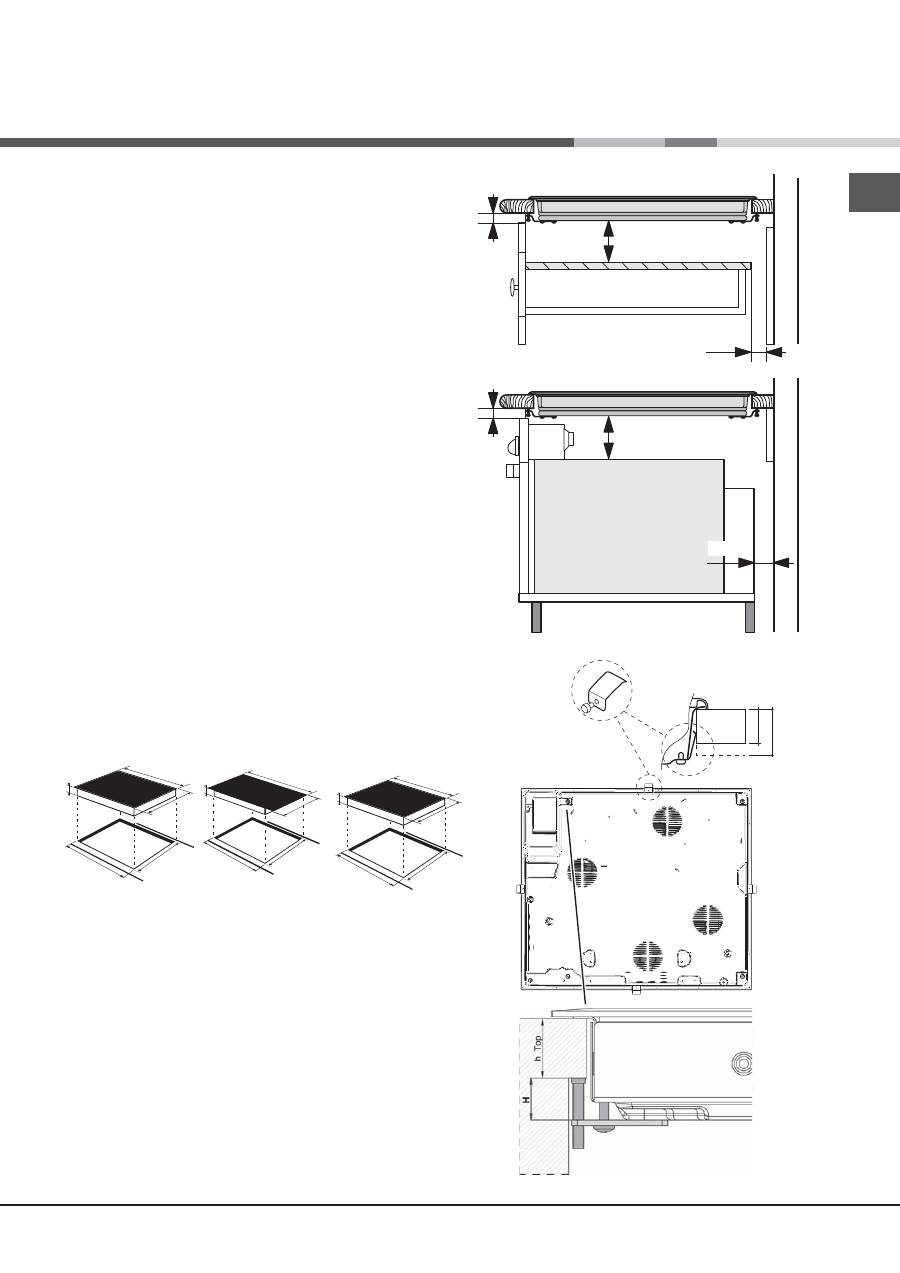
7
GB
Installation
!
Before operating your new appliance please read
this instruction booklet carefully. It contains important
information concerning the safe operation, installation
and maintenance of the appliance.
!
Please keep these operating instructions for future
reference. Pass them on to any new owners of the
appliance.
Positioning
!
Keep all packaging material out of the reach of
children. It may present a choking or suffocation
hazard (
see Precautions and tips
).
!
The appliance must be installed by a qualified
professional in accordance with the instructions
provided. Incorrect installation may cause harm to
people and animals or may damage property.
Built-in appliance
Use a suitable cabinet to ensure that the appliance
functions properly.
• The supporting surface must be heat-resistant up to
a temperature of approximately 100°C.
• If the appliance is to be installed above an oven,
the oven must be equipped with a forced ventilation
cooling system.
• Avoid installing the hob above a dishwasher: if this
cannot be avoided, place a waterproof separation
device between the two appliances.
• Depending on the hob you want to install, the
cabinet must have the following dimensions (
see
fi gure
):
Ventilation
To allow adequate ventilation and to avoid overheating of
the surrounding surfaces the hob should be positioned as
follows:
• At a minimum distance of 40 mm from the back
panel or any other vertical surfaces.
• So that a minimum distance of 20 mm is maintained
between the installation cavity and the cabinet
underneath.
• Kitchen cabinets adjacent to the appliance and taller
than the top of the hob must be at least 600 mm
from the edge of the hob.
FRONT SIDE
OF HOB
SUPPORTING
SURFACE
30
40
UNDERSIDE
OF HOB
5 mm
min. 20 mm
min. 20 mm
min. 40 mm
COMPARTMENT
5 mm
min. 40 mm
FAN-ASSISTED
OVEN
560 +/- 1
490 +/- 1
53
590
520
690
520
560 +/- 1
490 +/- 1
53
560 +/- 1
490 +/- 1
53
574
504
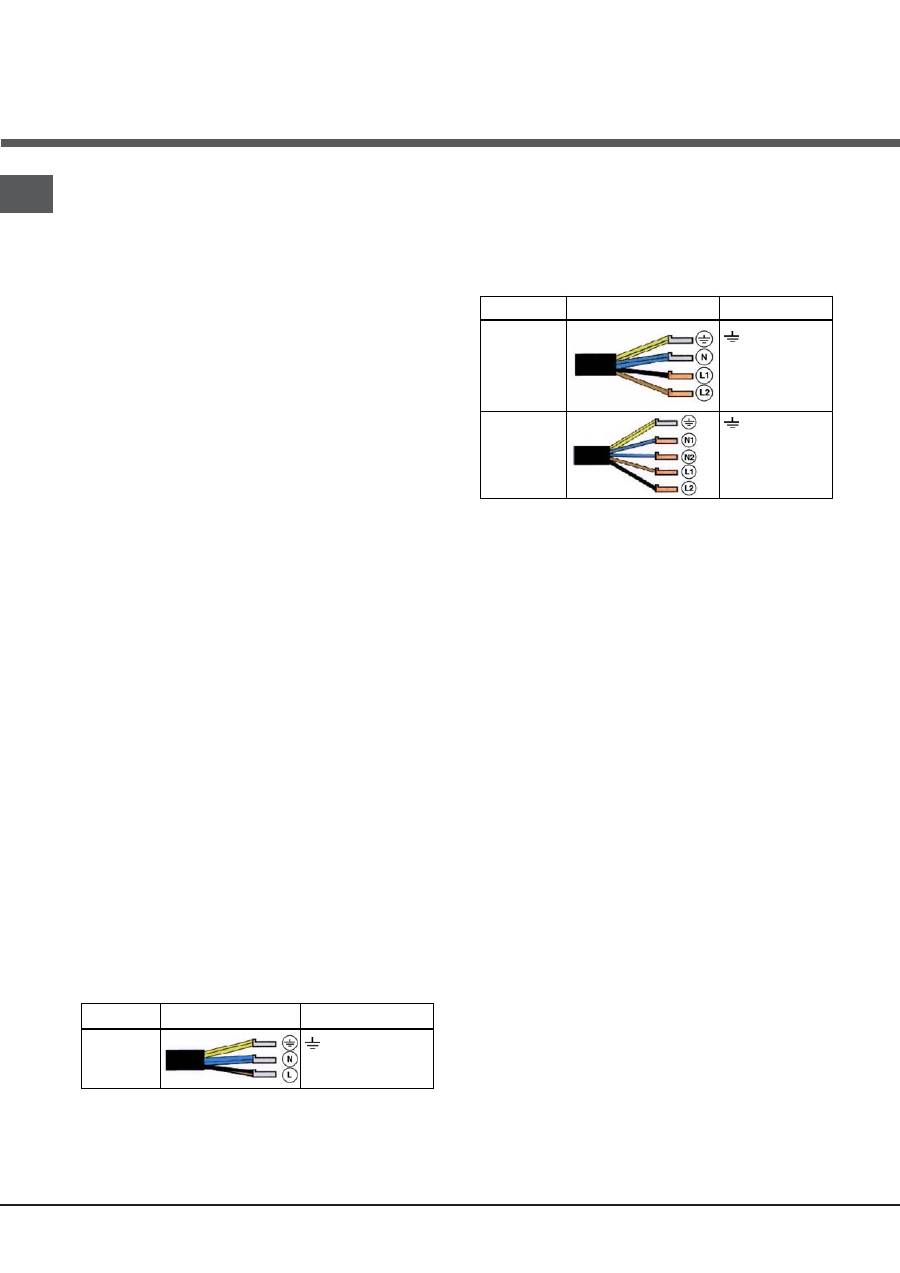
8
GB
Fixing
The appliance must be installed
on a perfectly level
supporting surface. Any deformities caused by
improper fixing could affect the features and operation
of the hob.
The thickness of the supporting surface should be taken
into account when choosing
the length of the screws for
the fixing hooks:
• 30 mm thick: 23 mm screws
• 40 mm thick: 13 mm screws
Fix the hob as follows:
1. Use short flat-bottomed screws to fix the 4 alignment
springs in the holes provided at the central point of each
side of the hob.
2. Place the hob in the cavity, make sure it is in a central
position and push down on the whole perimeter until the
hob is stuck to the supporting surface.
3. For hobs with raised sides: After inserting the hob into
its cavity, insert the 4 fixing hooks (each has its own pin)
into the lower edges of the hob, using the long pointed
screws to fix them in place, until the glass is stuck to the
supporting surface.
!
The screws for the alignment springs must remain
accessible.
!
In order to adhere to safety standards, the appliance
must not come into contact with electrical parts once it
has been installed.
!
All parts which ensure the safe operation of the
appliance must not be removable without the aid of a
tool.
Electrical connection
!
The electrical connection for the hob and for any built-
in oven must be carried out separately, both for safety
purposes and to make extracting the oven easier.
Single-phase connection
The hob is equipped with a pre-connected electricity
supply cable, which is designed for single-phase
connection. Connect the wires in accordance with the
instructions given in the following table and diagrams:
Voltage and
mains frequency
Electrical cable
Wire connection
220-240V 1+N ~
50 Hz
: yellow/green
N
: the two blue wires together
L
: brown and black together
Other types of connection
If the mains supply corresponds with one of the
following:
Voltage and mains frequency
• 400V - 2+N ~ 50 Hz
• 220-240V 3 ~ 50 Hz
• 400V 3 - N ~ 50 Hz
• 400V - 2+2N ~ 50 Hz
Separate the wires and connect them in accordance
with the instructions given in the following table and
diagrams:
Voltage and
mains frequency
Electrical cable
Wire connection
400V - 2+N ~
50 Hz
220-240V 3 ~
50 Hz
400V 3-N ~
50 Hz
: yellow/green;
N
: the two blue wires
together
L1
: black
L2
: brown
400V - 2+2N ~
50 Hz
: yellow/green;
N1
: blue
N2
: blue
L1
: black
L2
: brown
Connecting the electricity supply cable to the mains
If the appliance is being connected directly to the
electricity mains an omnipolar switch must be installed with
a minimum opening of 3 mm between contacts.
!
The installer must ensure that the correct electrical
connection has been made and that it is fully compliant
with safety regulations.
Before connecting the appliance to the power supply,
make sure that:
• The appliance is earthed and the plug is compliant with
the law.
• The socket can withstand the maximum power of the
appliance, which is indicated on the data plate located
on the appliance itself.
• The voltage falls within the range of values indicated on
the data plate.
• The socket is compatible with the plug of the appliance.
If the socket is incompatible with the plug, ask an
authorised technician to replace it. Do not use extension
cords or multiple sockets.
!
Once the appliance has been installed, the power
supply cable and the electrical socket must be easily
accessible.
!
The cable must not be bent or compressed.
!
The cable must be checked regularly and replaced
by authorised technicians only.
!
The manufacturer declines any liability should
these safety measures not be observed.
!
Do not remove or replace the power supply cable
for any reason. Its removal or replacement will void
the warranty and the CE marking. INDESIT does not
assume liability for accidents or damage arising from
replacement/removal of the original power supply
cable. Replacement can only be accepted when
carried out by personnel authorised by INDESIT and
using an original spare part.

9
GB
Start-up and use
!
The glue applied on the gaskets leaves traces of
grease on the glass. Before using the appliance, we
recommend you remove these with a special non-
abrasive cleaning product. During the first few hours
of use there may be a smell of rubber which will
disappear very quickly.
!
A few seconds after the hob is connected to the electricity
supply, a buzzer will sound. The hob may now be switched
on.
Types of noise during normal hob operation:
• Buzz: due to the vibration of the metallic parts that
make up the induction element and the pot; it is
generated by the electromagnetic field required for
heating and increases as the power of the induction
element increases.
• Soft whistle: heard when the pot placed on the
heating zone is empty; the noise disappears once
food or water is placed into the pot.
• Crackle: produced by the vibration of materials on
the bottom of the pot due to the flow of parasitic
currents caused by electromagnetic fields
(induction); can be more or less intense depending
on the material making up the bottom of the pot, and
decreases as the pot dimensions increase.
• Loud whistle: heard when two induction elements of
the same group function simultaneously at maximum
power and/or when the booster function is set on
the larger element while the other is auto-adjusted.
Noise is reduced by decreasing the power level of
the auto-adjusted induction element; pot bottom
layers made of different kinds of materials are
among the main causes of this noise.
• Fan noise: a fan is necessary to ensure the hob
functions correctly and to safeguard the electronic
unit from possible overheating. The fan functions at
maximum power when the large induction element is at
maximum power or when the booster function is on; in
all other cases, it works at average power depending
on the temperature detected. Furthermore, the fan may
continue to work even after switching the hob off, if the
temperature detected is high.
The types of noise listed above are due to induction
technology and are not necessarily operational faults.
!
If the
-
or
+
button is pressed for an extended
period of time, the display scrolls quickly though the
power levels and timer minutes.
Switching on the hob
To switch the hob on, press and hold the
button for
approximately one second.
Switching on the cooking zones
Each cooking zone is controlled using a selector button
and a power adjustment device consisting of a
double
-
and
+
button.
• To begin operating a cooking zone, press the
corresponding control button and set the desired
power level (between 0 and 9) using the buttons
-
and
+
.
Booster function*
The booster function for some of the cooking zones may
be used to shorten heating-up times. It may be activated
by pressing the
Booster
button. The indicator light directly
above the button will illuminate. This function boosts
the power to 2000 W or 3000 W, depending on the size
of the relevant cooking zone.
The booster stops automatically after 4 minutes. While
the booster for one of the cooking zones is active, the
corresponding front or rear cooking zone will operate
at a reduced power level (e.g. if the booster for the
rear left-hand hotplate has been activated, the power
level of the front left-hand hotplate will be reduced).
For further information, please refer to the
Technical
description of the models
.
Switching off the cooking zones
To switch off a cooking zone, select it using the
corresponding selector button
and:
• Press the
-
button: the power of the cooking zone
will progressively decrease until it is switched off.
Programming the cooking duration
!
All the cooking zones may be programmed
simultaneously, for a duration between 1 and 99
minutes.
1. Select the cooking zone using the corresponding
selector button.
2. Adjust the power level of the cooking zone.
*
Only available in certain models.
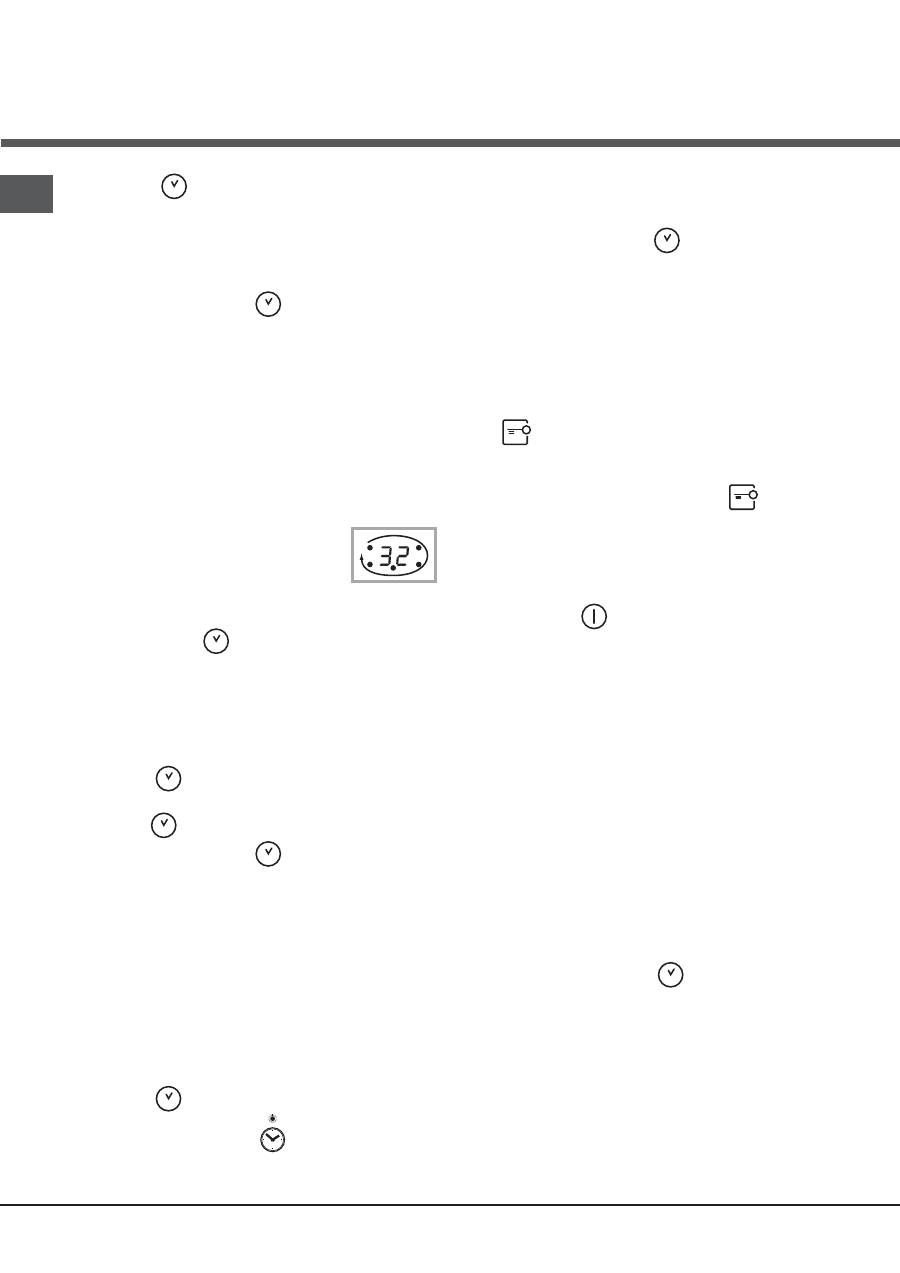
10
GB
3. Press the
programming button. The indicator
light corresponding to the selected zone will start
flashing.
4. Set the cooking duration using the
-
and
+
buttons.
5. Confirm by pressing the
button or automatic
selection occurs after 10 seconds.
The timer begins counting down immediately. A buzzer
sounds for approximately 1 minute and the cooking
zone switches off when the set programme has
finished.
Repeat the above procedure for each hotplate you
wish to programme.
Using multiple programmes and the display
If one or more hotplates are programmed, the display
will show the data for the hotplate with
the least time remaining, and the light
corresponding to the position of the
hotplate will flash. The lights corresponding
to the other hotplates programmed will be switched on.
To visualise the time remaining for the other programmed
hotplates, press the
button repeatedly: the time
remaining for each hotplate will be shown sequentially
in a clockwise order, starting from the front left
hotplate.
Changing the programme
1. Press the
button repeatedly until the duration you
wish to change is shown.
2. Use the
buttons to set the new duration.
3. Confirm by pressing the
button.
To cancel a programme, follow the above instructions. At
step 2, press the
-
button: the duration decreases
progressively until it reaches 0 and switches off. The
programme resets and the display exits programming
mode.
Timer
The hob must be switched on.
The timer can be used to set a duration up to 99 minutes.
1. Press the
programming button until the timer
indicator light is illuminated
.
2. Set the desired duration using the
-
and
+
buttons.
3. Confirm by pressing the
button.
The timer begins counting down immediately. When
the time has elapsed, a buzzer will sound (for one
minute).
Control panel lock
When the hob is switched on, it is possible to lock the oven
controls in order to avoid accidental changes being made
to the settings (by children, during cleaning, etc.). Press
the
button to lock the control panel: the indicator
light above the button will switch on.
To use any of the controls (e.g. to stop cooking), you
must switch off this function. Press the
button for a
few moments, the indicator light will switch off and the
lock function will be removed.
Switching off the hob
Press the button
to switch off the appliance - do not
rely solely on the pan sensor.
If the control panel lock has been activated, the
controls will continue to be locked even after the hob is
switched on again. In order to switch the hob on again,
you must first remove the lock function.
“Demo” mode
It is possible to set the hob to a demonstration mode where
all the controls work normally but the heating elements do
not switch on. To activate the “demo” mode the hob must
be switched on, with all the hotplates switched off.
• Press and hold the
+
and
-
buttons simultaneously
for 6 seconds. When the 6 seconds have elapsed,
the ON/OFF and CONTROLS LOCKED indicator
lights will flash for one second. Release the
+
and
-
buttons and press the
button;
• The display will show the text DE and MO and the hob
will be switched off.
• When the hob is switched on again it will be set to the
“demo” mode.
To exit this mode, follow the procedure described above.
The display will show the text DE and OF and the hob will
be switched off. When it is next switched on, the hob will
function normally.
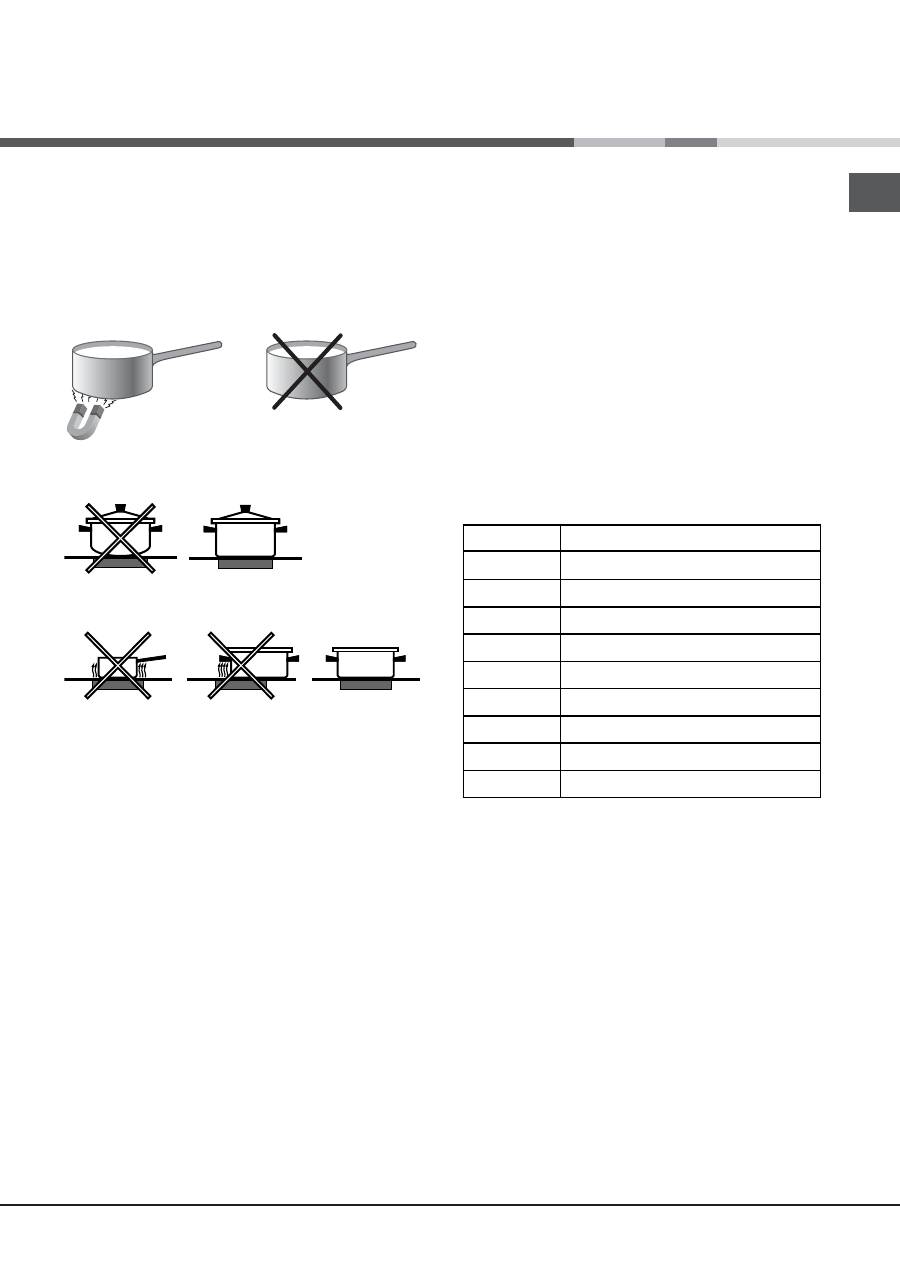
11
GB
Practical advice on using the appliance
!
Use cookware made from materials which are
compatible with the induction principle (ferromagnetic
material). We especially recommend pans made
from: cast iron, coated steel or special stainless
steel adapted for induction. Use a magnet to test the
compatibility of the cookware.
*
SUITABLE
UNSUITABLE
Cast iron
Enamelled steel
Special stainless steel
Copper,
Aluminium, Glass, Earthenware,
Ceramic, non magnetic Stainless steel
In addition, to obtain the best results from your hob:
• Use pans with a thick, flat base in order to fully utilise the
cooking zone.
• Always use pans with a diameter which is large
enough to cover the hotplate fully, in order to use all the
available heat.
• Make sure that the base of the cookware is always clean
and dry, in order to fully utilise and extend the life of both
the cooking zones and the cookware.
• Avoid using the same cookware which has been used
on gas burners: the heat concentration on gas burners
may distort the base of the pan, causing it not to adhere
correctly.
Safety devices
Pan sensor
Each cooking zone is equipped with a pan sensor device.
The hotplate only emits heat when a pan with suitable
measurements for the cooking zone is placed on it. If the
indicator light is flashing, it may indicate:
• An incompatible pan
• A pan whose diameter is too small
• The pan has been removed from the hotplate.
Overheating protection
If the electronic elements overheat, the hob switches off
automatically and
F
appears on the display, followed by
a flashing number. When the temperature has reached
a suitable level, this message disappears and the hob
may be used again.
Safety switch
The appliance has a safety switch which automatically
switches the cooking zones off after they have been in
operation for a certain amount of time at a particular power
level. When the safety switch has been triggered, the
display shows “0”.
For example: the right rear hotplate is set to 5 and will
switch off after 5 hours of continuous operation, while
the front left hotplate is set to 2 and will switch off after
8 hours.
Power level
1
2
3
4
5
6
7
8
9
Maximum operating time in hours
9
8
7
6
5
4
3
2
1
Buzzer
This can also indicate several irregularities:
• An object (a pan, cutlery, etc.) has been placed on the
control panel for more than 10 seconds.
• Something has been spilt on the control panel.
• A button has been pressed for too long. All of the above
situations may cause the buzzer to sound. Remove the
cause of the malfunction to stop the buzzer. If the cause
of the problem is not removed, the buzzer will keep
sounding and the hob will switch off.
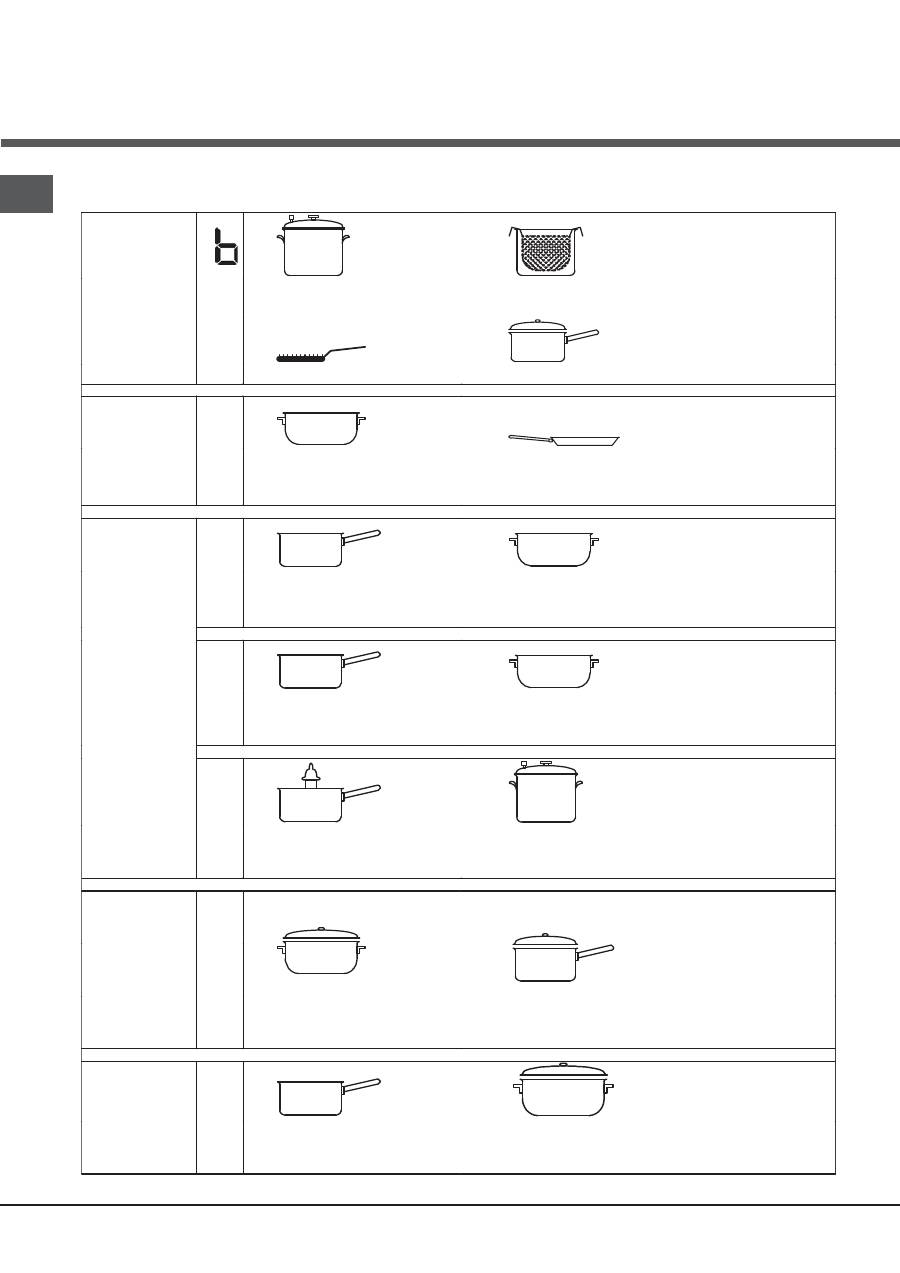
12
GB
Practical cooking advice
ª
Pressure cooking
Pressure cooker
Frying
Grilling
Boiling
Very high-flame
cooking
High-flame
cooking
Medium-flame cooking
Low-flame
cooking
Very
low-flame
cooking
• • ¶
Crêpes
Cooking on a high flame and browning
(roasts, steaks, escalopes, fish fillets,
fried eggs)
¶ §
Fast thickening (liquid juices)
Boiling water (pasta, rice, vegetables)
Milk
§ S
Slow thickening (dense juices)
S ¢
Bain-marie cooking
Pressure cooking after whistle
¢ £ ™
Low-flame cooking (stews)
Reheating dishes
™ ¡
Chocolate sauce
Keeping food hot

13
GB
Precautions and tips
!
This appliance has been designed and manufactured
in compliance with international safety standards. The
following warnings are provided for safety reasons and
must be read carefully.
This appliance conforms to the following
European Economic Community directives:
- 2006/95/EEC dated 12/12/06 (Low Voltage) and
subsequent amendments;
- 2004/108/EEC dated 15/12/04 (Electromagnetic
Compatibility) and subsequent amendments;
- 93/68/EEC dated 22/07/93 and subsequent amendments.
- 1275/2008 stand-by/off mode.
General safety
!
Make sure that the air inlet behind the fan grille is
never obstructed. The built-in hob should, in fact, be
provided with suitable ventilation for the cooling of the
electronic components used in the appliance.
!
We advise against the installation of an induction hob
above an under-the-counter refrigerator (heat) or above
a washing machine (vibrations). In fact, there would
be insufficient space for the ventilation of electronic
components.
• The appliance was designed for domestic use inside
the home and is not intended for commercial or
industrial use.
• The appliance must not be installed outdoors, even in
covered areas. It is extremely dangerous to leave the
appliance exposed to rain and storms.
• Do not touch the appliance when barefoot or with wet or
damp hands and feet.
• The appliance must be used by adults only for the
preparation of food, in accordance with the instructions
provided in this booklet. Do not use the hob as a
worktop or chopping board.
• The glass ceramic hob is resistant to mechanical
shocks, but it may crack (or even break) if hit with a
sharp object such as a tool. If this happens, disconnect
the appliance from the electricity mains immediately and
contact a Service Centre.
• Ensure that power supply cables of other electrical
appliances do not come into contact with the hot parts
of the hob.
• Remember that the cooking zones remain relatively hot
for at least thirty minutes after they have been switched
off. An indicator light provides a warning when residual
heat is present (
see Start-up and use
).
• Keep any object which could melt away from the
hob, for example plastic and aluminium objects, or
products with a high sugar content. Be especially
careful when using plastic film and aluminium foil or
packaging: if placed on surfaces which are still hot,
they may cause serious damage to the hob.
• Always make sure that pan handles are turned
towards the centre of the hob in order to avoid
accidental burns.
• When unplugging the appliance, always pull the
plug from the mains socket; do not pull on the cable.
• Never perform any cleaning or maintenance work
without having disconnected the appliance from the
electricity mains.
• The appliance should not be operated by people
(including children) with reduced physical, sensory
or mental capacities, by inexperienced individuals
or by anyone who is not familiar with the product.
These individuals should, at the very least, be
supervised by someone who assumes responsibility
for their safety or receive preliminary instructions
relating to the operation of the appliance.
• For the attention of wearers of pacemakers or other
active implants:
The hob complies with all current standards on
electromagnetic interference.
Your induction hob is therefore perfectly in keeping
with legal requirements (89/336/CEE directives). It
is designed not to create interference on any other
electrical apparatus being used on condition that
the apparatus in question also complies with this
legislation.
Your induction hob generates short-range magnetic
fields.
To avoid any interference between your induction
hob and a pacemaker, the latter must be designed
to comply with relevant regulations.
In this respect, we can only guarantee our own
product conformity. Please consult the pacemaker
manufacturer or your doctor concerning its
conformity or any possible incompatibility.
• Do not let children play with the appliance.
• Do not place metal objects (knives, spoons, pan
lids, etc.) on the hob as they may become hot.
•
The appliance is not intended to be operated by
means of an external timer or separate remote-
control system.
Disposal
• When disposing of packaging material: observe local
legislation so that the packaging may be reused.
• The European Directive 2002/96/EC relating to Waste
Electrical and Electronic Equipment (WEEE) states
that household appliances should not be disposed of
using the normal solid urban waste cycle. Exhausted
appliances should be collected separately in order to
optimise the cost of re-using and recycling the materials
inside the machine, while preventing potential damage
to the atmosphere and to public health. The crossed-out
dustbin is marked on all products to remind the owner of
their obligations regarding separated waste collection.
For further information relating to the correct disposal of
exhausted household appliances, owners may contact
the public service provided or their local dealer.

14
GB
Care and maintenance
Switching the appliance off
Disconnect your appliance from the electricity supply
before carrying out any work on it.
Cleaning the appliance
!
Do not use abrasive or corrosive detergents
(for example, products in spray cans for cleaning
barbecues and ovens), stain removers, anti-rust
products, powder detergents or sponges with abrasive
surfaces: these may scratch the surface beyond repair.
!
Never use steam cleaners or pressure cleaners on the
appliance.
• It is usually sufficient simply to wash the hob using
a damp sponge and dry it with absorbent kitchen
towel.
• If the hob is particularly dirty, rub it with a special
glass ceramic cleaning product, then rinse well and
dry thoroughly.
• To remove more stubborn dirt, use a suitable
scraper. Remove spills as soon as possible, without
waiting for the appliance to cool, to avoid residues
forming crusty deposits. You can achieve excellent
results by using a rust-proof steel wire sponge -
specifically designed for glass ceramic surfaces -
soaked in soapy water.
• If any plastic or sugary substances are accidentally
melted on the hob, remove them immediately with
the scraper, while the surface is still hot.
• Once it is clean, the hob may be treated with
a special protective maintenance product: the
invisible film left by this product protects the surface
from drips during cooking. This maintenance task
should be carried out while the appliance is warm
(not hot) or cold.
• Always remember to rinse the appliance well with
clean water and dry it thoroughly: residues can
become encrusted during subsequent cooking
processes.
Stainless steel frame
(only in models with outer frame)
Stainless steel can be marked by hard water which has
been left on the surface for a long time, or by cleaning
products containing phosphorus.
After cleaning, it is advisable to rinse the surface well
and dry it thoroughly. If water is spilt on the surface,
dry it quickly and thoroughly.
!
Some hobs have an aluminium frame which is
similar to stainless steel. Do not use any cleaning or
degreasing products which are not suitable for use
with aluminium.
Disassembling the hob
If it is necessary to disassemble the hob:
1. Loosen the screws fixing the alignment springs on
each side.
2. Loosen the screws holding the fixing hooks in each
corner.
3. Take the hob out of its installation cavity.
!
Do not attempt to repair the appliance yourself. If the
appliance breaks down, contact a Service Centre.
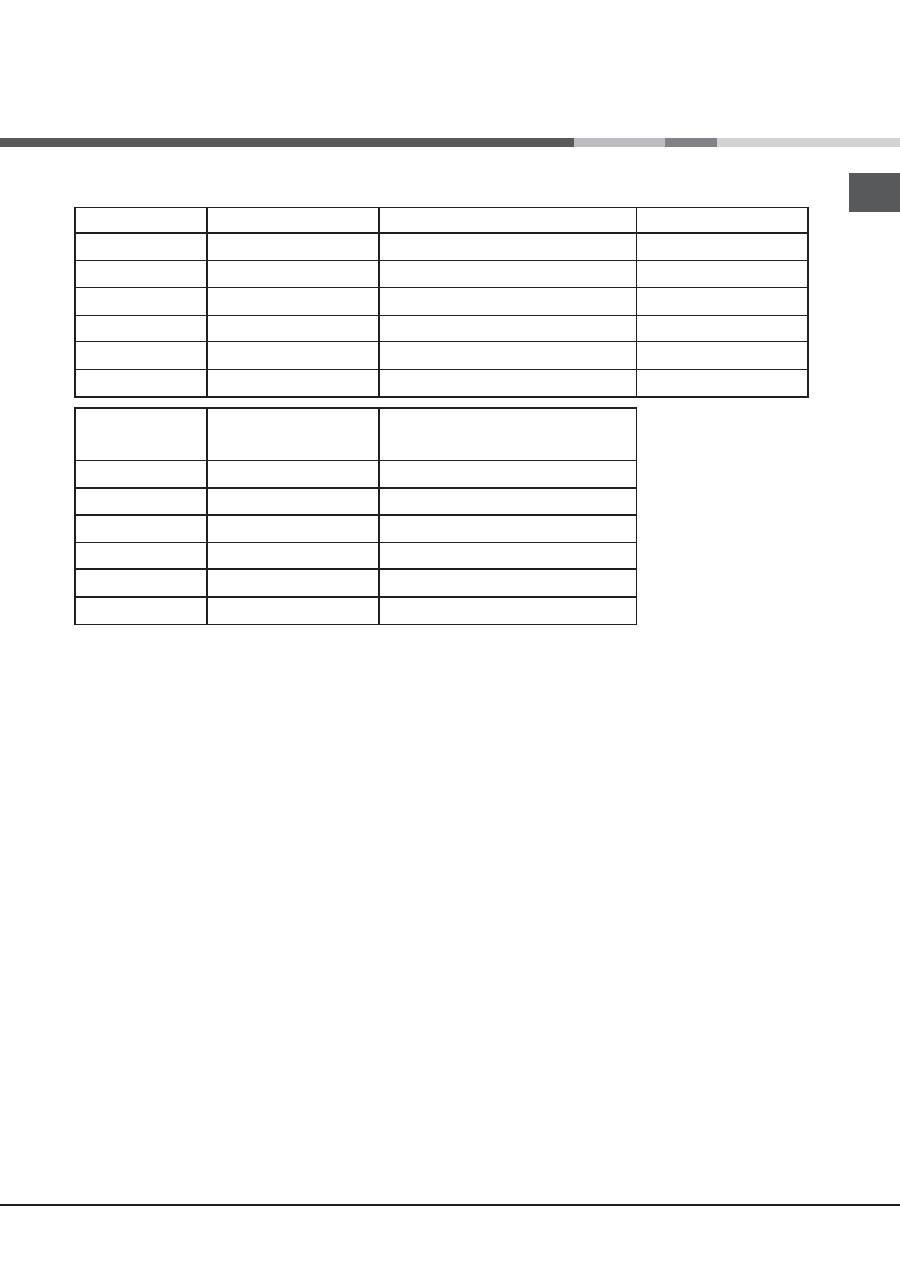
15
GB
Technical description of
the models
The induction system is the quickest existing way of cooking. Unlike traditional hotplates where the cooking zone
heats up, with the induction system heat is generated directly inside pans which have ferromagnetic bases.
Hobs
Cooking zone
Back Left
Back Right
Front Left
Front Right
Total power
KIA 641 C;KIA 641 B
Power (W)
I 1400
I 2200 - B 3000*
I 2200
I 1400 - 600 if Back Right*
7200
KIC 641 X
Power (W)
I 1400
I 2200 - B 3000*
I 2200
I 1400 - 600 if Back Right*
7200
KIC 644 DD Z
Power (W)
I 1400 - B 2000* - 600 if Front Left*
I 2200 - B 3000* - 1600 if Front Right*
I 2200 - B 3000* - 1600 if Back Left*
I 1400 - B 2000* - 600 if Back Right*
7200
Hobs
Cooking zone
Back Left
Back Right
Front Left
Front Right
Total power
KIC 642 C
Power (W)
I 1400 - 600 if Front Left*
I 2200 - B 3000*
I 2200 - B 3000*
I 1400 - 600 if Back Right*
7200
KIC 644 X
KIC 644 C
KIC 744 C
Power (W)
I 1400 - B 2000* - 600 if Front Left*
I 2200 - B 3000* - 1600 if Front Right*
I 2200 - B 3000* - 1600 if Back Left*
I 1400 - B 2000* - 600 if Back Right*
7200
Key:
I = single induction cooking zone
B = booster: the power level of the cooking zone may be boosted to 3000 W
* = the maximum power level is limited while the booster is activated for the relevant rear cooking zone (see
Start-up
and use
).
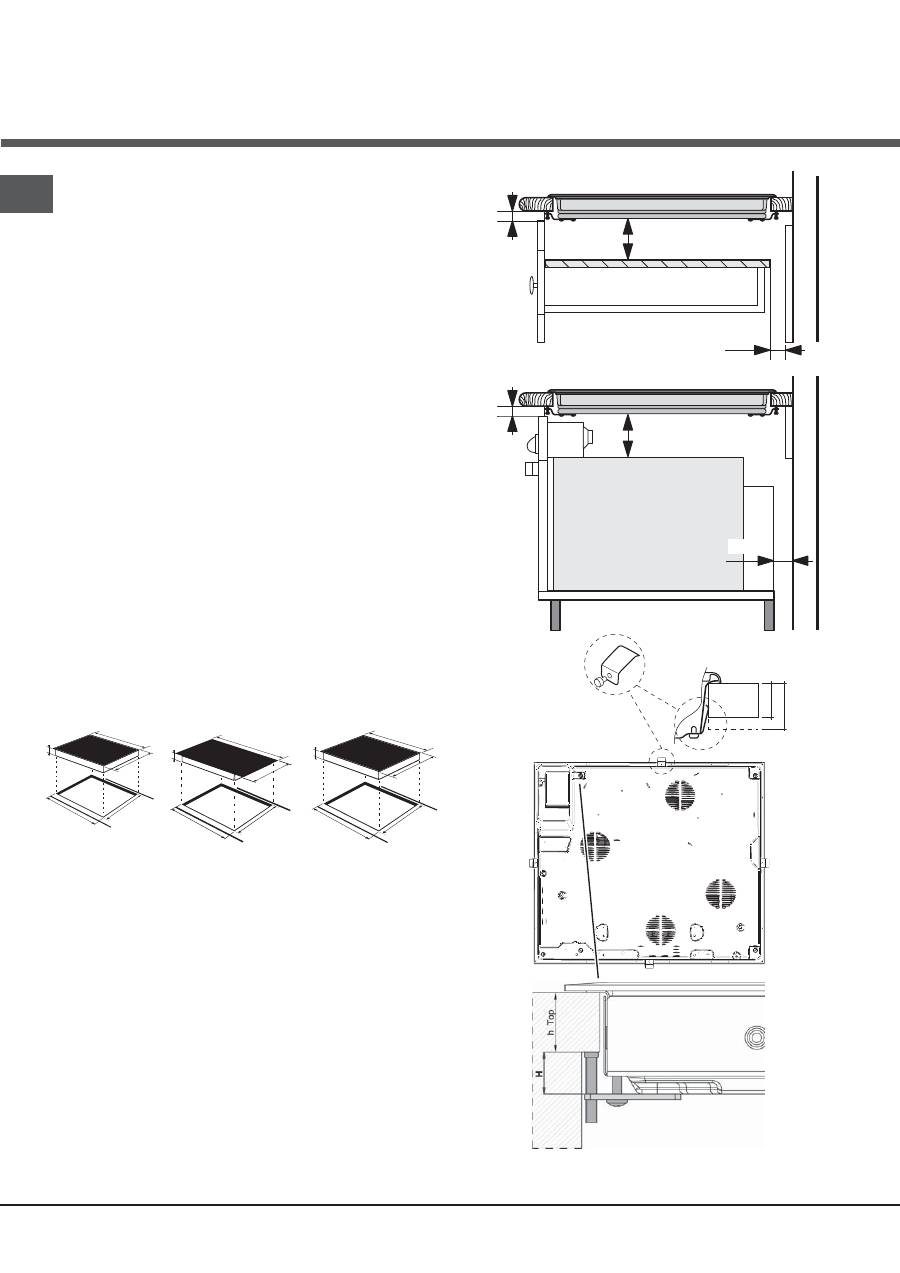
16
FR
Installation
!
Conserver ce mode d’emploi pour pouvoir le consulter
à tout moment. En cas de vente, de cession ou de
déménagement, veiller à ce qu’il suive l’appareil pour
informer le nouveau propriétaire sur son fonctionnement et lui
fournir les conseils correspondants.
!
Lire attentivement les instructions : elles contiennent des
conseils importants sur l’installation, l’utilisation et la sécurité
de cet appareil.
Positionnement
!
Les emballages ne sont pas des jouets pour enfants, il faut
les mettre au rebut en respectant la réglementation sur le tri
sélectif des déchets (
voir Précautions et conseils
).
!
L’installation doit être effectuée par un professionnel du
secteur conformément aux instructions du fabricant. Une
mauvaise installation peut causer des dommages à des
personnes, des animaux ou des biens.
Encastrement
Pour garantir le bon fonctionnement de l’appareil, il faut que
le meuble possède des caractéristiques bien précises :
• le matériau du plan d’appui doit pouvoir résister à une
température d’environ 100°C ;
• en cas d’installation de la table de cuisson au-dessus d’un
four, il faut que ce dernier soit équipé d’un dispositif de
refroidissement par ventilation forcée ;
• éviter d’installer la table de cuisson au-dessus d’un lave-
vaisselle : si c’est le cas, prévoir une séparation étanche
entre les deux appareils ;
• selon la table de cuisson à installer (
voir fi gures
), la
découpe du meuble doit avoir les dimensions suivantes :
Aération
Pour permettre une bonne aération et pour éviter
toute
surchauffe des surfaces autour de l’appareil, la table de
cuisson doit être positionnée :
• à au moins 40 mm de distance du mur arrière ou de toute
autre surface verticale;
• de manière à ce qu’il reste au moins 20 mm de distance
entre la découpe d’encastrement et le meuble en
dessous.
• Les meubles jouxtant la table, dont la hauteur dépasse
celle du plan de cuisson, doivent être placés à au moins
600 mm du bord du plan.
5 mm
min. 20 mm
min. 20 mm
min. 40 mm
TIROIR
5 mm
min. 40 mm
CHALEUR
TOURNANTE
CÔTÉ AVANT DE LA
TABLE DE CUISSON
PLAN DE
TRAVAIL
30
40
TABLE DE CUISSON
RETOURNÉE
560 +/- 1
490 +/- 1
53
590
520
690
520
560 +/- 1
490 +/- 1
53
560 +/- 1
490 +/- 1
53
574
504
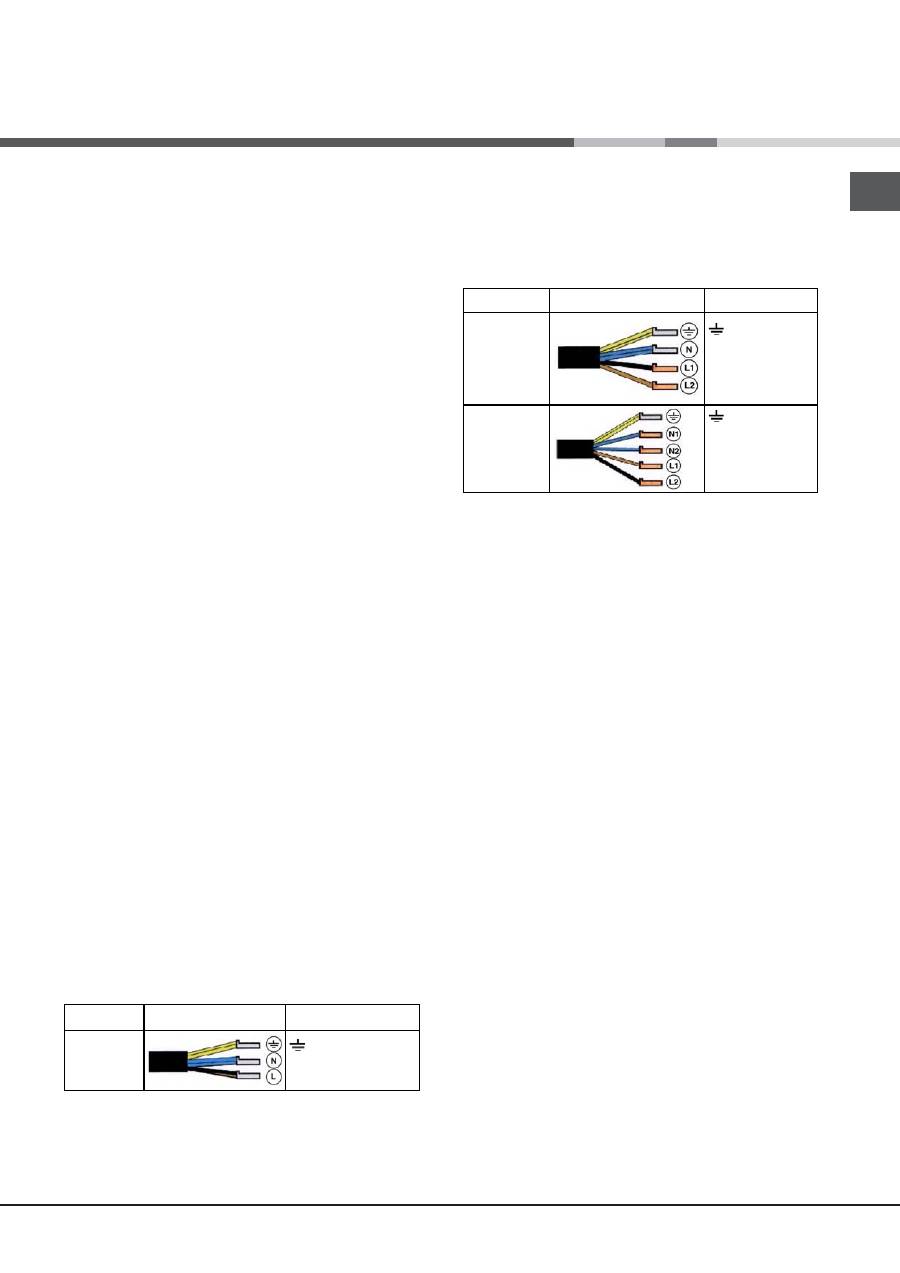
17
FR
• 400V - 2+N ~ 50 Hz
• 220-240V 3 ~ 50 Hz
• 400V 3 - N ~ 50 Hz
• 400V - 2+2N ~ 50 Hz
Séparer les câbles et procéder au raccordement des fils en
suivant les indications du tableau et des dessins suivants :
Tension type et
fréquence réseau
Cordon électrique
Raccordement fils
400V - 2+N ~
50 Hz
220-240V 3 ~
50 Hz
400V 3-N ~
50 Hz
: jaune/vert;
N
: les 2 fils bleus
ensemble
L1
: noir
L2
: marron
400V - 2+2N ~
50 Hz
: jaune/vert;
N1
: bleu
N2
: bleu
L1
: noir
L2
: marron
Branchement du câble d’alimentation au réseau
électrique
En cas de raccordement direct au réseau, il faut intercaler
entre l’appareil et le réseau un interrupteur à coupure
omnipolaire ayant au moins 3 mm d’écartement entre les
contacts.
!
L’installateur est responsable du bon raccordement
électrique de l’appareil et du respect des normes de
sécurité.
Avant de procéder au branchement, s’assurer que :
• la prise est bien munie d’une terre conforme à la loi;
• la prise est bien apte à supporter la puissance maximale
de l’appareil, indiquée sur la plaque signalétique de
l’appareil ;
• la tension d’alimentation est bien comprise entre les
valeurs indiquées sur la plaque signalétique;
• la prise est bien compatible avec la fiche de l’appareil. Si
ce n’est pas le cas, remplacer la prise ou la fiche, ne pas
utiliser de rallonges ni de prises multiples.
!
Après installation de l’appareil, le câble électrique et la
prise de courant doivent être facilement accessibles
!
Le câble ne doit être ni plié ni excessivement écrasé.
!
Le câble doit être contrôlé périodiquement et ne peut être
remplacé que par un technicien agréé.
!
Nous déclinons toute responsabilité en cas de non
respect des normes énumérées ci-dessus.
!
Ne retirer ou ne remplacer en aucun cas le câble
d’alimentation. Toute opération d’enlèvement ou de
remplacement annule automatiquement la garantie et la
marque CE INDESIT décline toute responsabilité en cas
d’accidents ou de dommages dérivants de l’enlèvement ou
du remplacement du câble d’alimentation original. Seul le
remplacement effectué par un technicien agréé INDESIT
utilisant une pièce détachée originale est autorisé.
Fixation
Il est impératif d’assurer
l’encastrement de l’appareil sur un
plan d’appui parfaitement plat.
Les déformations provoquées par une mauvaise fixation
risquent d’altérer les caractéristiques de la table de cuisson
ainsi que ses performances.
La longueur de la vis de réglage des crochets de fixation
doit être réglée avant leur montage selon l’épaisseur du plan
d’appui :
• épaisseur 30 mm : vis 23 mm;
• épaisseur 40 mm : vis 13 mm.
Pour sa fixation, procéder comme suit :
1. Se servir des vis courtes sans pointe pour visser les 4
ressorts de centrage dans les trous prévus sur chaque côté
de la table, en leur milieu;
2. insérer la table de cuisson dans la découpe prévue, bien
au centre et bien appuyer tout autour du cadre pour que la
table adhère parfaitement au plan d’appui.
3. pour les tables avec profils latéraux : après avoir encastré
la table de cuisson dans la découpe, insérer les 4 crochets
de fixation (chacun avec son goujon) sur le périmètre
inférieur de la table de cuisson et visser avec les vis longues
à pointe jusqu’à ce que le verre adhère bien au plan d’appui.
!
Il faut absolument que les vis des ressorts de centrage
soient accessibles.
!
Conformément aux normes de sécurité, après encastrement
de l’appareil, il ne doit plus y avoir possibilité de contact
avec les parties électrifiées.
!
Toutes les parties qui servent de protection doivent être
fixées de manière à ne pouvoir être enlevées qu’avec l’aide
d’un outil.
Raccordement électrique
!
Le branchement électrique de la table de cuisson et
celui d’un éventuel four à encastrer doivent être effectués
séparément, pour des raisons de sécurité électrique et pour
pouvoir démonter plus facilement le four en cas de besoin.
Raccordement monophasé
La table est fournie déjà équipée d’un cordon d’alimentation
prévu pour raccordement monophasé. Procéder au
raccordement des fils en suivant les indications du tableau et
des dessins suivants :
Tension type et
fréquence réseau
Cordon électrique
Raccordement fils
220-240V 1+N ~
50 Hz
: jaune/vert;
N
: les 2 fils bleus ensemble
L
: le marron avec le noir
Autres types de branchement
Si l’installation électrique correspond à une des
caractéristiques suivantes :
Tension type et fréquence réseau
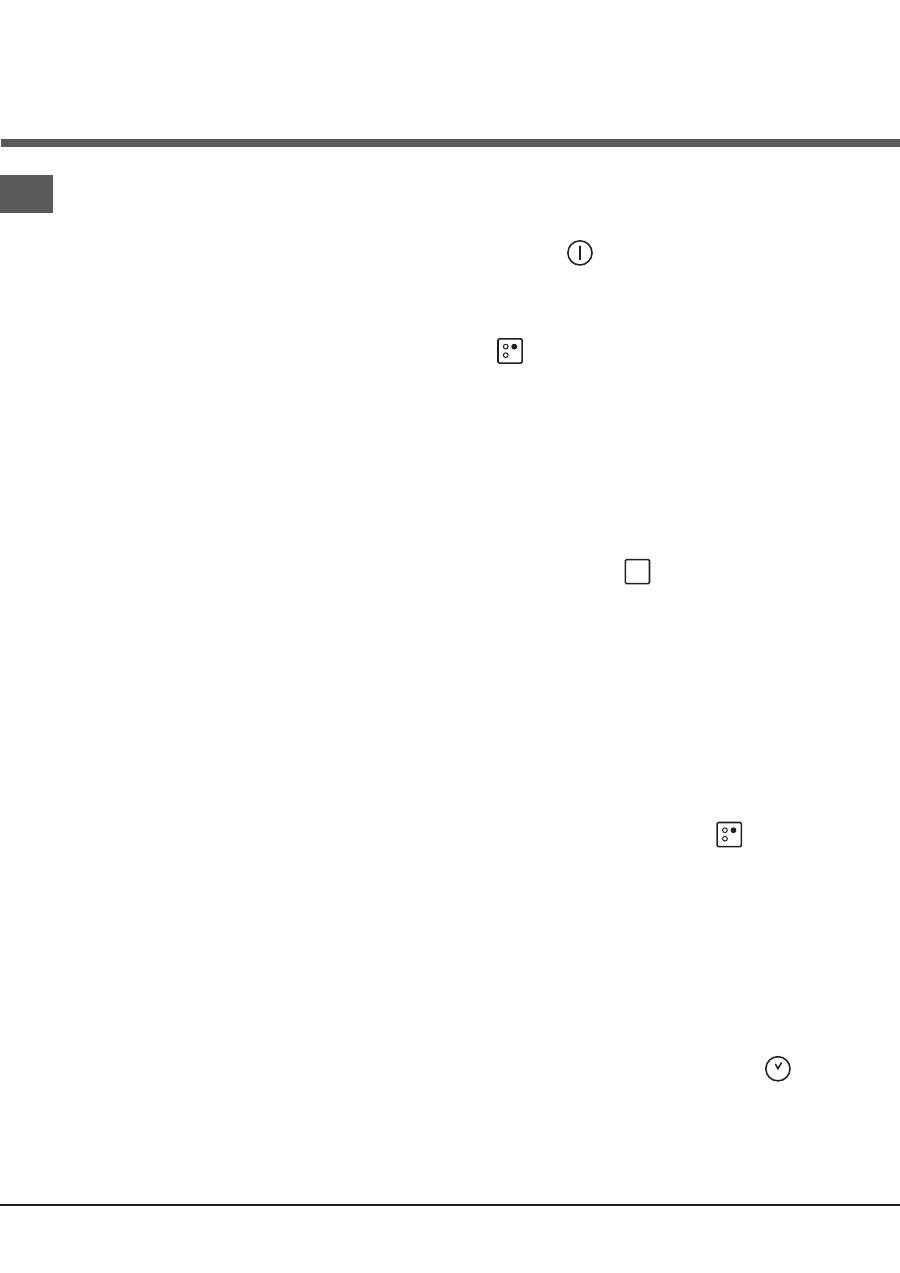
18
FR
Mise en marche et
utilisation
!
La colle utilisée pour les joints laisse des traces
de graisse sur le verre. Nous conseillons de les
éliminer avant d’utiliser l’appareil à l’aide d’un produit
d’entretien non abrasif. Une odeur de caoutchouc
peut se dégager au cours des premières heures
d’utilisation, elle disparaîtra très vite.
!
Un bip retentit quelques secondes après la mise sous
tension de la table de cuisson. A partir de ce moment-
là, l’allumage de la table est possible.
Bruits de fonctionnement normaux de la table de
cuisson :
• Bourdonnement : il est dû à la vibration des
éléments métalliques qui composent le générateur
et le récipient de cuisson. Il est produit par le champ
électromagnétique nécessaire à la montée en
température ; il augmente au fur et à mesure que le
niveau de puissance du générateur augmente.
• Léger sifflement : il se produit quand la casserole
posée sur le foyer est vide; le bruit disparaît dès
qu’on y introduit de l’eau ou des aliments.
• Crépitement : il s’agit d’un bruit produit par les
vibrations du matériau composant le fond de la
casserole quand il est traversé par les courants
parasites dus au champ électromagnétique
(induction) ; il est plus ou moins intense selon le
type de matériau utilisé pour le fond et il diminue au
fur et à mesure que les dimensions de la casserole
augmentent.
• Sifflement intense : il se produit quand les deux
générateurs fonctionnent en même temps sur la
même verticale à leur puissance maximale et/ou
quand la fonction booster est insérée sur le plus
grand d’entre eux et que l’autre est autorégulé.
Le bruit diminue dès qu’on baisse le niveau de
puissance du générateur autorégulé; il est plus
manifeste quand le fond de la casserole est formé
de plusieurs couches de matériaux différents.
• Bruit du ventilateur : pour un fonctionnement
correct de la table et pour garantir la sécurité des
composants électroniques contre tout risque de
surchauffe, il faut actionner un ventilateur. Le
ventilateur fonctionne à sa puissance maximum
quand le générateur plus grand est à son niveau de
puissance maximum ou quand la fonction booster
est insérée; dans tous les autres cas, il fonctionne
à sa puissance intermédiaire selon la température
détectée. Il se peut d’ailleurs que le ventilateur
continue à fonctionner même après la désactivation
de la table si la température détectée est trop
élevée.
Les bruits énumérés sont rattachés à la technologie de
l’induction et ne signalent pas forcément des défauts
de fonctionnement.
!
Une pression prolongée sur les touches
-
et
+
accélère l’avancement rapide des niveaux de
puissance et des minutes du minuteur.
Mise sous tension de la table de cuisson
Pour mettre la table de cuisson sous tension, appuyer
sur la touche
pendant une seconde environ.
Allumage des foyers
Chaque foyer est activé par une touche de sélection
et par un dispositif de réglage de la puissance
à double touche
-
et
+
.
• Pour mettre en marche un foyer, appuyer sur la
commande correspondante et sélectionner la
puissance voulue à l’aide des touches
-
et
+
.
Fonction booster*
Pour accélérer la montée en température, une fonction
booster est disponible sur certains foyers, pour l’activer
appuyer sur la touche
Booster
. Le voyant placé au-dessus
de la touche s’allume. Cette fonction suralimente la
puissance à 2000 ou 3000W selon la dimension du
foyer concerné.
Le booster s’arrête automatiquement après 4 minutes.
Tant que le booster d’un foyer est activé, la puissance
du foyer correspondant avant ou arrière est limitée (par
ex : si le booster est activé sur le foyer arrière gauche,
la puissance du foyer avant gauche baisse). Pour de
plus amples renseignements, consulter
Description
technique des modèles
.
Extinction des foyers
Pour éteindre un foyer, le sélectionner à l’aide de la
touche de sélection correspondante
et :
• Appuyez sur la touche
-
: la puissance du foyer
descend progressivement jusqu’à extinction.
Programmation de la durée de cuisson
!
Il est possible de programmer simultanément tous les
foyers pour une durée comprise entre 1 et 99 minutes.
1. Sélectionner le foyer à l’aide de la touche de
sélection correspondante.
2. Régler le niveau de puissance du foyer.
3. Appuyer sur la touche de programmation
. Le
voyant correspondant au foyer sélectionné clignote.
4. Sélectionner la durée de cuisson désirée à l’aide
des touches
-
et
+
.
*
N’existe que sur certains modèles
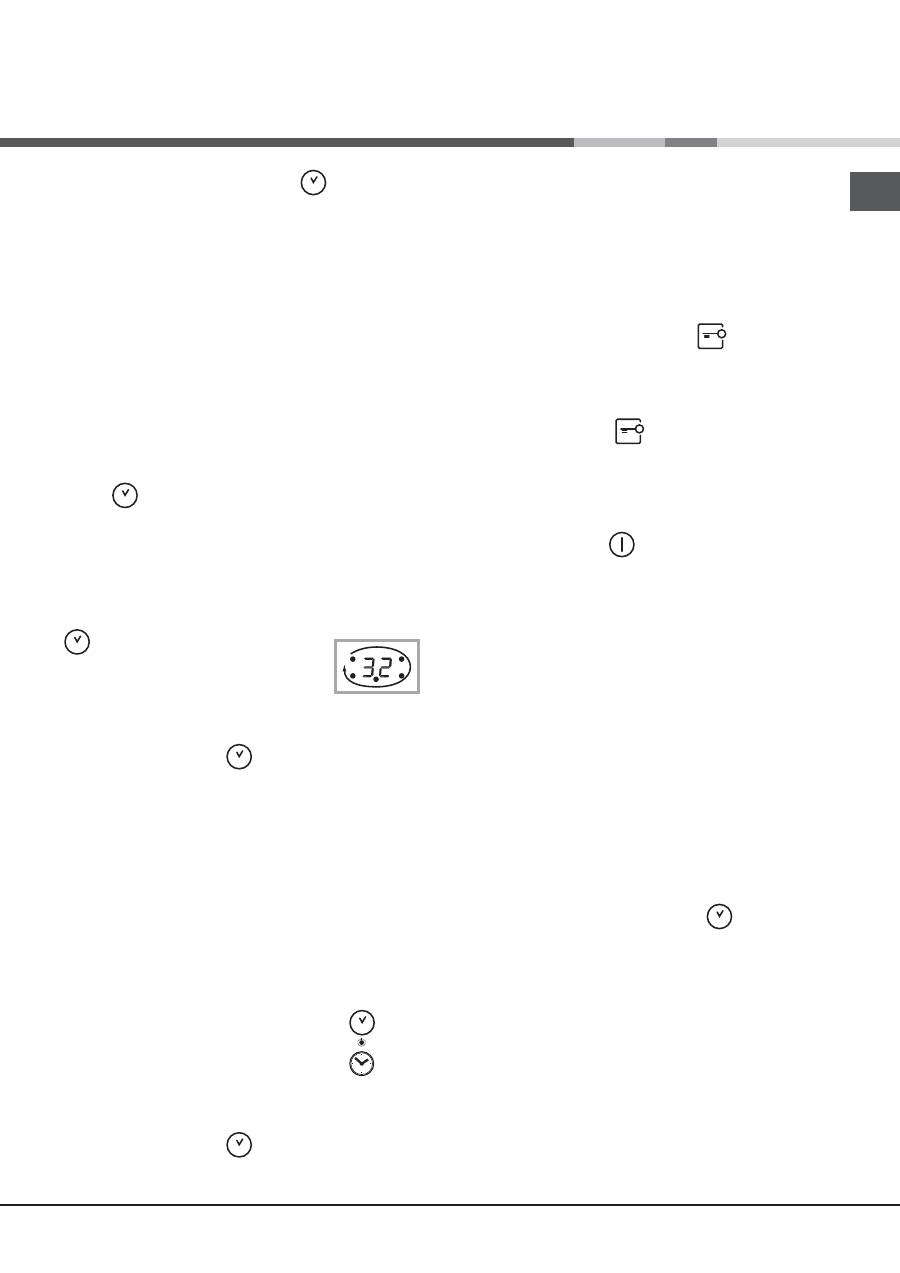
19
FR
5. Valider en appuyant sur la touche
, sinon la
sélection se fait automatiquement au bout de 10
secondes. Le compte à rebours du minuteur démarre
aussitôt. La fin de la cuisson programmée est indiquée
par un signal acoustique (durée 1 minute) et le foyer
s’éteint. Procéder de même pour tous les foyers devant
être programmés.
Affichage en cas de programmation multiple
En cas de programmation d’un ou de plusieurs foyers,
l’écran affiche le temps restant pour le foyer qui se
rapproche le plus de la fin du temps programmé,
dont la position est indiquée par clignotement du
voyant correspondant. Les voyants des autres foyers
programmés sont allumés.
Pour afficher le temps restant des autres foyers
programmés, appuyer plusieurs fois de suite sur la
touche
: il y aura affichage à la suite et dans le
sens des aiguilles d’une montre des temps du minuteur
et de tous les foyers programmés, en partant du foyer
avant gauche.
Modifier la programmation
1. Appuyer plusieurs fois de suite sur la touche
, jusqu’à affichage du temps
correspondant au foyer devant être
modifié.
2. Sélectionner un nouveau temps à
l’aide des touches
-
et
+
.
3. Appuyer sur la touche
pour valider.
Pour annuler une programmation, procéder comme
indiqué plus haut. Au point 2, appuyer sur la touche
-
: la durée diminue progressivement jusqu’à l’extinction
0. La programmation est remise à zéro et l’afficheur
quitte le mode programmation.
Le minuteur
La table de cuisson doit être allumée.
Le minuteur permet de sélectionner une durée de 99
minutes maximum.
1. Appuyer sur la touche de programmation
.
Jusqu’à ce que le voyant minuteur s’allume
.
2. Sélectionner la durée désirée à l’aide des touches
-
et
+
.
3. Appuyer sur la touche
pour valider.
Le compte à rebours du minuteur démarre aussitôt.
Une fois le temps écoulé, un signal sonore retentit
(pendant 1 minute).
Verrouillage des commandes
Pendant le fonctionnement de la table, il est possible
de verrouiller les commandes pour empêcher toute
intervention extérieure sur le réglage (enfants,
nettoyage...). Appuyer sur la touche
pour
verrouiller les commandes, le voyant situé au-dessus
de la touche s’allume.
Pour pouvoir modifier les réglages (interrompre la
cuisson par ex.) il faut déverrouiller les commandes
: appuyer sur la touche
pendant quelques
instants, le voyant s’éteint et les commandes sont
déverrouillées.
Extinction de la table de cuisson
Appuyer sur la touche
pour éteindre l’appareil. Ne
pas se fier au détecteur de casserole.
Si les commandes de l’appareil ont été verrouillées,
elles le seront encore au rallumage de la table. Pour
pouvoir rallumer la table de cuisson, il faut d’abord
déverrouiller les commandes.
Mode Démonstration (demo)
Il est possible de sélectionner une utilisation en mode
démonstration où le tableau de bord fonctionne
normalement (y compris les commandes concernant
la programmation) mais où les éléments chauffants ne
s’allument pas. Pour activer le mode démonstration
(demo), il faut que la table soit sous tension et que tous
les foyers soient éteints :
• Appuyer simultanément sur les touches + et – et
les garder enfoncées pendant 6 secondes. Au
bout de 6 secondes, le voyant ON/OFF et le voyant
VERROUILLAGE DES COMMANDES se mettent à
clignoter pendant une seconde. Lâcher les touches
+
et
–
et appuyer sur la touche
;
• il y a affichage de DE et de MO et la table s’éteint;
• au rallumage successif, la table se trouvera en
mode démonstration (demo).
Pour quitter ce mode de fonctionnement, suivre la
procédure décrite plus haut. Il y a affichage de DE et
de OF et la table s’éteint. Au rallumage successif, la
table fonctionnera normalement.
Conseils d’utilisation de l’appareil
!
Utiliser des récipients dont le matériau est compatible
avec l’induction (matériau ferromagnétique). Nous
recommandons l’utilisation de casseroles en : fonte,
acier émaillé ou inox spécial induction. Pour s’assurer
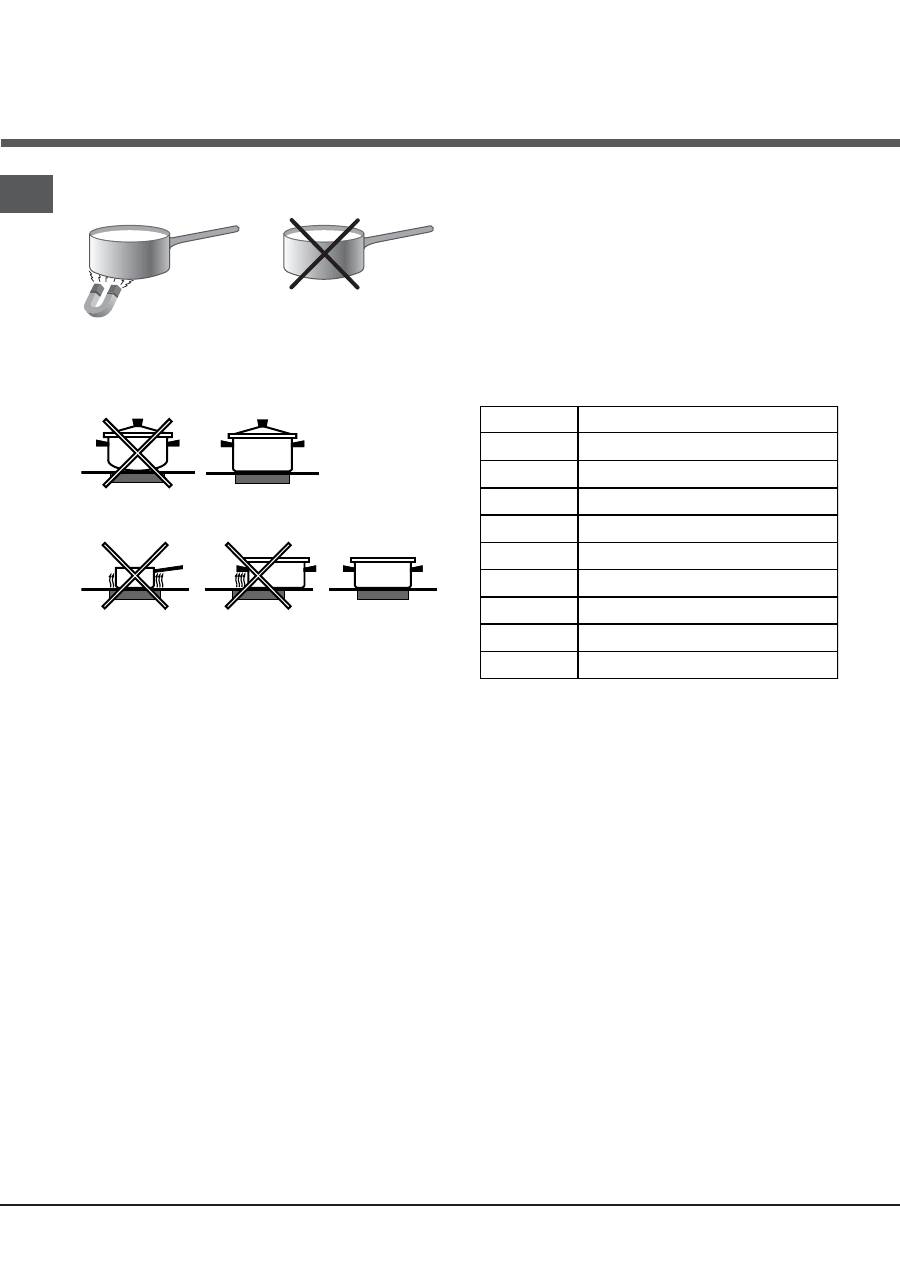
20
FR
de la compatibilité d’un récipient, effectuer un test
avec un aimant.
*
A UTILISER
NE CONVIENT PAS
Fonte
Acier émaillé
Inox spécial
Cuivre
Aluminium, Verre, Terre,
Céramique, Inox non magnétique
Pour obtenir de meilleures performances de la table de
cuisson :
• Utiliser des casseroles à fond plat et de forte
épaisseur pour qu’elles adhèrent parfaitement à la
zone de chauffe
• Utiliser des casseroles dont le diamètre couvre
complètement la zone de chauffe de façon à ce que
toute la chaleur disponible puisse être utilisée.
• Veiller à ce que la base des casseroles soit toujours
parfaitement sèche et propre pour garantir un bon
contact et une longue durée de vie des foyers mais
aussi des casseroles.
• Eviter d’utiliser les mêmes casseroles que sur les
brûleurs à gaz. la concentration de chaleur sur les
brûleurs à gaz peut déformer le fond de la casserole
qui perd de son adhérence.
Les sécurités
Détection de récipient
Chaque foyer est équipé d’une détection de casserole.
Le foyer ne délivre de puissance qu’en présence d’une
casserole adaptée au foyer. Le voyant clignotant peut
signaler :
• une casserole incompatible
• une casserole de trop petit diamètre
• que la casserole a été soulevée
Surchauffe
En cas de surchauffe de ses composants
électroniques, la table s’éteint automatiquement et
l’afficheur indique
F
suivi d’un chiffre clignotant. Cet
affichage disparaît et la table est à nouveau utilisable
dès que la température est redescendue à un niveau
acceptable.
Interrupteur sécurité
L’appareil est équipé d’un interrupteur de sécurité
qui interrompt instantanément le fonctionnement des
foyers dès qu’un temps limite de fonctionnement à
un niveau de puissance donné est atteint. Pendant
l’interruption de sécurité, l’afficheur indique “0”.
Exemple : le foyer arrière droit est réglé sur 5, tandis
que le foyer avant gauche est réglé sur 2. Le foyer
arrière droit s’éteindra au bout de 5 heures de
fonctionnement tandis que le foyer avant gauche
s’éteindra au bout de 8 heures.
Puissance
1
2
3
4
5
6
7
8
9
Durée limite de fonctionnement
9
8
7
6
5
4
3
2
1
Signal sonore
Des anomalies, comme par exemple :
• un objet (casserole, couvert, ...) placé plus de 10
secondes sur la zone de commande,
• un débordement sur la zone de commande,
• une pression prolongée sur une touche,
peuvent déclencher un signal sonore. Eliminer la
cause de dysfonctionnement pour stopper le signal
sonore. Si la cause de l’anomalie n’est pas éliminée,
le signal sonore continue à retentir et la table
s’éteint.

